WANT TO WIN $100 CASH?

See page 4 of second section for details!


See page 4 of second section for details!


NEW GLARUS, Wis.
– Kami and Jesse Dorn are Guernsey lovers through and through. Born and raised around the fawn and white bovines, the Dorns have eyes only for Guernseys. Their favorite of the dairy breeds, Kami and Jesse are in tune with the qualities that make the Guernsey desirable in every category from type to production to longevity.
“Guernseys have evolved over the years, and they are a lot stronger and more resilient than people give them credit for,” Kami said. “We focus on dairy strength and better legs while keeping the Guernsey’s trademark golden milk.”
The Dorns farm with Jesse’s parents, Mary Kay and Dennis, at Kadence Farm near New Glarus. The family milks 65 cows and farms 700 acres. Kami and Jesse have built a herd separate from his parents using the prex, Gold Rush, and now
the younger Dorns own more than half of the 100% registered Guernsey herd.
Their work has not gone unnoticed. In 2020, Kami and Jesse received the Outstanding Young Farmer Award through the American Guernsey Association.
“We have three generations of Gold Rush animals, and they’re pretty much all homebred,” Jesse said.
Guernseys are a long-lived tradition in the Dorn family with Jesse being the fourth generation to carry on the breed. Guernsey roots run deep in Kami’s family as well. She grew up on a Guernsey farm near Platteville, and her grandparents also had a Guernsey herd.
It was the Guernsey breed that brought Kami and Jesse together, as the two met while showing cattle. When her parents retired in 2017, Kami brought some of her Guernseys with her to Kadence Farm. Her dad, Duane Schuler, is housing cattle on the farm as well under the prex, Donnybrook.
“I like that I can continue Kami’s family’s herd with her being gone from the farm,” Jesse said. “That’s important to me. We have a winter calf we’re super excited about because she
is the rst animal to represent all three of our herds.”



Owned by Jesse and Kami, Gold Rush Lincoln Rock n’ Roll is sired by Jesse’s parents’ bull, and her great-granddam traces
back to Kami’s dad’s animal. The barn at Kadence Farm is lled with notable cattle like Kadence Sherlock Spiced Latte
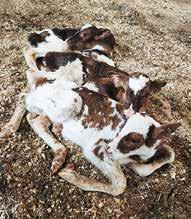 By Danielle Nauman danielle.n@dairystar.com
By Danielle Nauman danielle.n@dairystar.com
Triplets are not typically an everyday occurrence on a dairy farm.
To have heifer calves, all born healthy and thriving, is an even more rare occurrence.

That is exactly what happened on two Wisconsin dairy farms in a 24-hour time period.
Triplet Brown Swiss heifers were born April 4 at the farm owned by Morgan and Sandy Long, where Nathan Campshure works as the herd manager, near Brillion, Wisconsin.
Campshure milks 105 cows in a tiestall barn with the

Longs. Most of the herd consists of Holsteins.
Campshure and the Longs are in the planning stages of a farm transition. They purchased two Brown Swiss cows – including a cow named Skyler – from Campshure’s broth-
er-in-law, Mitch Kappelman, who operates Meadow Brook Dairy in Manitowoc, Wisconsin, with his family.
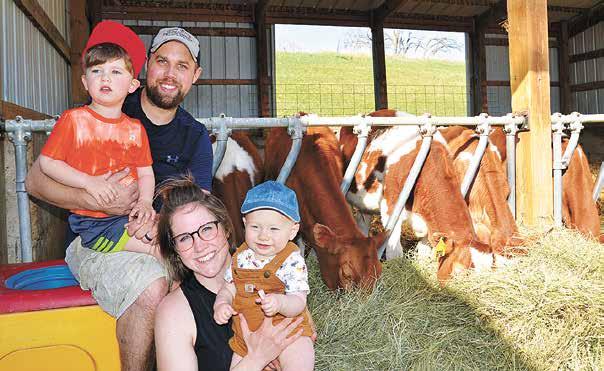
“Skyler was my pick of Mitch’s 2-year-old group of Brown Swiss,” Campshure said. “He had her on shots to
5


breed, so he bred her to Cozy Nook Doboy Tank before she came over to our place.”
That service led to the triplets that were born earlier this
month at the Longs’ farm. Campshure said he had no idea Skyler was carrying triplets.
“A time or two, I wondered if she could be carrying twins, but triplets never crossed my mind,” Campshure said. “As she got closer, I started to doubt that, because she was actually three days overdue when she calved.”
Campshure said that as Skyler began the early stages of labor, he left to go feed steers at a second farm. When he came back, rear feet of the rst calf had presented.
“I pulled that calf and checked to see if there was another,” Campshure said. “Sure enough, there was another set of rear feet coming, so I pulled that calf. I checked once more and found front feet of the third calf.”
Published by Star Publications LLC

General Manager/Editor
Mark Klaphake - mark.k@dairystar.com
320-352-6303 (ofce)
320-248-3196 (cell)
320-352-0062 (home)
Ad Composition - 320-352-6303
Nancy Powell • nancy.p@dairystar.com
Karen Knoblach • karen.k@star-pub.com
Annika Gunderson • annika@star-pub.com
Editorial Staff
Tiffany Klaphake - Assistant Editor
320-352-6303 • tiffany.k@dairystar.com
Maria Bichler - Assistant Editor
maria.b@dairystar.com • 320-352-6303
Danielle Nauman - Staff Writer
608-487-1101 • danielle.n@dairystar.com
Stacey Smart - Staff Writer
262-442-6666 • stacey.s@dairystar.com
Abby Wiedmeyer - Staff Writer
608-487-4812 • abby.w@dairystar.com
Grace Jeurissen - Staff Writer
320-352-6303 • grace.j@star-pub.com
Jan Lefebvre - Staff Writer
320-290-5980 • jan.l@star-pub.com
Amy Kyllo - Staff Writer amy.k@star-pub.com
Consultant
Jerry Jennissen 320-346-2292
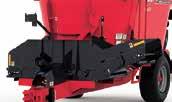

Advertising Sales
Main Ofce: 320-352-6303
Fax: 320-352-5647
Deadline is 5 p.m. of the Friday the week before publication
Sales Manager - Joyce Frericks
320-352-6303 • joyce@dairystar.com
Mark Klaphake (Western MN)
320-352-6303 (ofce) 320-248-3196 (cell)

Laura Seljan (National Advertising, SE MN)
507-250-2217 • fax: 507-634-4413 laura.s@dairystar.com
Jerry Nelson (SW MN, NW Iowa, South Dakota)
605-690-6260 • jerry.n@dairystar.com
Mike Schafer (Central, South Central MN)
320-894-7825 • mike.s@dairystar.com
Amanda Hoeer (Eastern Iowa, Southwest Wisconsin)
320-250-2884 • amanda.h@dairystar.com
Megan Stuessel (Western Wisconsin)
608-387-1202 • megan.s@dairystar.com
Kati Kindschuh (Northeast WI and Upper MI)
920-979-5284 • kati.k@dairystar.com
Julia Mullenbach (Southeast MN and Northeast IA)
507-438-7739 • julia.m@star-pub.com
Bob Leukam (Northern MN, East Central MN) 320-260-1248 (cell) bob.l@star-pub.com
The dairy market remains wary about the spring ush and the destination for that volume of milk. In the Midwest, a lot of that milk supply ends up in a cheese vat. “The good news is the consumer has been relatively resilient,” said Mike North, principal, Ever.Ag. “Cheese production has been very elevated, but the buildup of inventory has not followed its seasonal norm; we’re actually keeping the inventory static or even depleting it a little bit depending on what category you’re looking at.” Nearby Class III prices have been in the $18 per hundredweight range, while deferred contracts are in the $19 territory. “When we lay that against feed prices right now, none of those prices are exciting, and what we’re going to need is some sort of relief on feed costs or an ongoing push in the milk market to carry those margins higher,” North said.
The International Dairy Foods Association and Wisconsin Cheesemakers Association are petitioning the U.S. Department of Agriculture for a Federal Milk Marketing Order hearing to increase make allowance. The National Milk Producers Federation and American Farm Bureau Federation have objected to this proposal. USDA has until April 29 to issue an action plan to complete a hearing within 120 days, request more information from IDFA and WCMA, or reject the request.
Federal order reform should go beyond ‘make allowances’

The American Dairy Coalition is asking Agriculture Secretary Tom Vilsack to deny the FMMO hearing petitions made by two dairy processor groups. ADC CEO Laurie Fischer said federal order reform is needed, but
these petitions focus exclusively on “make allowances.”
“We do not support ‘make allowance’ updates based on processors having the ability to voluntarily participate in the cost surveys which undoubtedly would exclude essential relevant data,” Fischer said.
“Farmers need transparency in order to understand how their net payment is calculated, and these ‘make allowances’ are not line items; they are embedded in pricing formulas.”
WOTUS override vetoed
By Don Wick Columnist
President Joe Biden delivered a veto rejecting a congressional effort that would have overturned the Waters of the United States rule. In a statement, Biden said the attempt to block WOTUS would increase uncertainty and threaten agriculture’s economic growth. The House and Senate used the Congressional Review Act to invalidate the controversial EPA rule. WOTUS is also being reviewed in the courts, including the U.S. Supreme Court.
A coalition of 131 farm and food groups have sent a letter to congressional leaders, calling for checkoff reform in the 2023 farm bill. The groups claim the checkoff programs have “well-documented histories of waste,








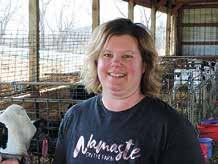
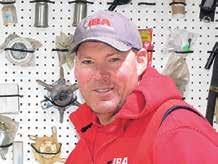




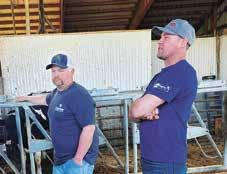










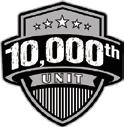
TRACTORS
5525, FWA, cab, w/542 JD ldr & bkt, 6,100 hrs .. $39,000
JD 5065E, FWA, cab, w/loader & bucket, SS mount. $51,000
Allis Chalmers 180, gas................................................. $4,900
‘13 MF 8670, FWA, w/1,699 hrs. 2013 ................... $164,000
Massey Ferguson 20 Industrial, gas, 2WD

w/Lloader & Bucket ................................................ Coming In
COMBINES
Gleaner 9250-35 Draper Head....................... $37,000
‘09 Gleaner 8200-35 Flex Head w/Orbit Reel ...... $18,000
Gleaner 8200-35 Flex Head w/Crary Air Reel... Coming In
Gleaner 8200-30 Flex Head w/Crary Air Reel... Coming In
‘05 Harvestec 4306C 6 Row 30” Cutter Corn Head, Gleaner Mounts .................................................. $17,500

‘00 Geringhoff Rd630 Corn Head, Consigned, Gleaner Mounts .................................................. $14,000
Gleaner 313 Pick-Up Header .................................. $3,500


SKIDS, TRACK LOADERS, TELE-HANDLERS, & EXCAVATORS


‘07 Bobcat S185 Skid Steer, Cab, 4900 Hrs .... Coming In

‘14 Bobcat S570 Skid Steer, Cab, w/5,100 Hrs, H/F Control, 2 Sp. ............................................ Coming In
‘15 Bobcat S590, Skid Steer, 2330 Hrs, Single Spd........................................................ Coming In

Bobcat T595 Track Loader, Cab, Hvac, 1500 Hrs, H/F Control 2sp................................................... $46,000
‘16 Bobcat T770 Track Loader, Cab, Hvac, 3,000 Hrs, H/F Controls, Track Sus...................................... $45,000
Mustang 2032 Skid Steer, 3000 Hrs, 1-Owner, H/F Controls ..................................................... Coming In
‘14 NH L218 Skid Steer, H/F Ctrls, Single Spd, Cab Heat........................................................... Coming In
TILLAGE/FIELD CULTIVATORS

CIH 335 VT 25’ Vertical Tillage True Tandem ...... $51,000

Con nued from AG INSIDER | Page 2 conicts of interest, misuse of funding, anti-competitive behavior and other related issues.” The signatories on the letter include the Environmental Working Group, National Farmers Union, Center for Food Safety and the Land Stewardship Project.
Culled cow numbers increase
Since the beginning of 2023, nearly 805,000 U.S. dairy cows have been culled. That’s up 27,000 head, or 3.5%, from the same time period last year.

Texas explosion kills 18,000 cows
An explosion and re at Southfork Dairy near Dimmitt, Texas, resulted in the loss of 18,000 dairy cows and the hospitalization of one employee. The cause of the explosion is being investigated. “This was the deadliest barn re for cattle in Texas history and the investigation and cleanup may take some time,” said Texas Agriculture Commissioner Sid Miller. “There are lessons to be learned, and the impact of this re may inuence the immediate area and the industry itself. Once we know the cause and the facts surrounding this tragedy, we will make sure the public is fully informed so tragedies like this can be avoided in the future.”
Baldwin touts dairy initiative

During her Delivering for Wisconsin Tour, U.S. Sen. Tammy Baldwin highlighted the direct support she brought back to the state. One of the stops was the Marieke Gouda Cheese Shop in Thorp, Wisconsin, where she discussed her Dairy Business Innovation Initiative. This program was included in the 2018 farm bill and helps dairy businesses diversify products, expand markets and encourage the use of regional milk production.
Canada is looking for farmers
A new report indicates Canada is facing a signicant shortage of farmers. The report was commissioned by the Royal Bank of Canada, the Boston Consulting Group Centre and the University of Guelph. It says more than 40% of Canadian farmers will retire over the next 10 years. A policy analyst cited inationary concerns, land affordability and succession planning as the big issues. Sixty-six percent of Canadian farmers do not have a succession plan in place.
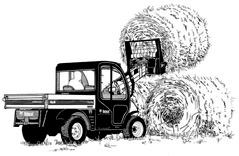

Haag leads PDPW
The Professional Dairy Producers board of directors has elected its new ofcer team. John Haag, of Dane, Wisconsin, is the new president. Janet Clark, of Rosendale, Wisconsin, is vice president. Corey Hodorff, of Eden, Wisconsin, is secretary and Brady Weiland, of Columbus, Wisconsin, is treasurer.
Dorn, McCullough added to WDE Board
World Dairy Expo has welcomed Kami Dorn of the Wisconsin Guernsey Breeders’ Association and Annie McCullough of Farm Journal to its board.
WCMA elects ofcer team
The incoming president of the Wisconsin Cheese Makers Association is Tim Omer of Emmi Roth, succeeding Steve Bechel of Eau Galle Cheese. Doug Wilke of Valley Queen Cheese is rst vice president, Mike Sipple of Agropur is second vice president, Kim Heiman of Nasonville Dairy is treasurer, and Chris Renard of Renard’s Cheese is secretary.
Junior Holstein honors
Three Junior Holstein Association members from Wisconsin have been selected as nalists for the Young Distinguished Junior Member Award. The nalists are Cathryn Gunst of Pine River, Christopher Gunst of Pine River and Dylan Ryan of Fond du Lac.

Trivia challenge
Gorgonzola is the popular blue cheese that originated in Italy. That answers our last trivia question. For this week’s trivia, what farm bill title represents the majority of the legislation’s nancial outlays? We will have the answer in our next edition of Dairy Star.
Don Wick is owner/broadcaster for the Red River Farm Network, based in Grand Forks, North Dakota. Wick has been recognized as the National Farm Broadcaster of the Year and served as president of the National Association of Farm Broadcasting. Don and his wife, Kolleen, have two adult sons, Tony and Sam, and ve grandchildren, Aiden, Piper, Adrienne, Aurora and Sterling.
The third calf presented correctly, but Campshure said he had to work with her to get her breathing well.
“I had to rub and stimulate her chest, but once she got going, she was great,” Campshure said. “She was actually the rst one to get up on her feet.”
The triplets’ birth marks the beginning of Skyler’s second lactation, and Campshure said she has been doing well following the delivery.
“It took her a bit to clean, but she did,” he said. “When she calved, I gave her warm water with dextrose in it, and I gave her IVs, polypropylene glycol and some rumen pills for a couple of days and nursed her along with some calf grain. But, she’s doing great now.”


The calves – which Campshure named Eins, Zwei and Drei – are doing well too.
“They were all around 70 to 80 pounds each,” he said. “They were all in their own placenta. I think that is why they were all so big and healthy.”

Campshure said naming the calves One, Two and Three in German is a nod to the German dialect spoken in Switzerland, the native homeland of the Brown Swiss breed.

“I nally was able to attend World Dairy Expo for the rst time last year,” Campshure said. “I went with Mitch, and we watched the Brown Swiss show, and I was so impressed with it and loved the yodelers.”





The next morning, as the Brown Swiss triplets were awakening to their second day of life, a set of polled Red and White triplets was entering the world at West Croix Holsteins and Jerseys on the other side of the state in St. Croix County near New Richmond, Wisconsin.
West Croix Holsteins and Jerseys is owned by Chris and Rikki Van Dyk and their family. The Van Dyks milk 70 cows in a tiestall barn that was rebuilt following a barn re that the Van Dyks



suffered in 2015.





“Our vet had conrmed that Nevalina was carrying twins,” said Chris Van Dyk. “I was a little surprised to nd three calves, and even more so when I realized they were all three heifers.”
Van Dyk said Nevalina had the calves by herself and was up and licking them when they discovered she had calved.
“Both Nevalina and the babies are all doing well so far,” Van Dyk said. “I gave her an IV right away to help prevent any problems and babied her for a few days to help her recover. The calves all drank well right away. They are very active and spunky.”
Van Dyk called the calves Jerseysized and said they weighed between 40 and 50 pounds each. He said there were at least two separate placentas.
Making the three little redheads –named Nellie, Nessie and Nettie – even more special was Van Dyk’s discovery that all three were polled.
The calves are sired by AvantGarde-I Latenite. Nevalina is a VG-85 Siemers Oct Apple-Crisp-ET daughter. Her mother, A Newbeginning, was the rst calf born in the new barn after the barn re. The Van Dyk family has been working with that particular cow family for over 25 yea rs.
In all his years dairy farming, Van Dyk said his family has never had triplets born much less triplet heifer calves.
“My vet said she has seen several sets, but there is almost always at least one bull calf in the mix,” Van Dyk said. “I don’t ever recall there even being twins in that particular cow family.”
Van Dyk said following the birth, he became interested in how often triplets are born to dairy cows.
“According to Google, only about one in every 105,000 bovine births are triplets,” Van Dyk said. “I feel pretty lucky, especially that all three are red, polled heifers, and that everyone is healthy and doing well.”
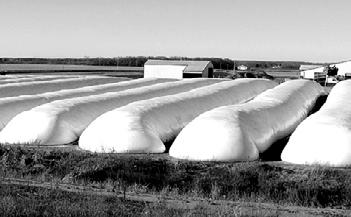
the No. 1 CPI cow in the Guernsey breed. Latte is one of the farm’s top producers and made over 30,000 pounds of milk last year.
“She does it all,” Kami said.
Showing is central to the Dorns who show at every level and exhibited at 13 shows last year.
“We show a lot, and we had a very successful year in 2022,” Jesse said. “We pretty much lived our dream. It was by far our best year yet.”
Two of their cows, Kadence Fame Lovely and Pond N Pines Nutter Butter (owned in partnership with Melissa Haag of Lodi) won their classes at Madison and Louisville and went on to become unanimous All-Americans. Lovely was also the total performance winner at both Madison and Louisville.
“That was pretty cool,” Jesse said. “Lovely is our dream cow. We’ve shown her six years in a row. She breeds back and does everything you could ask a cow to do.”
Other showstoppers included Spiced Latte and Kadence Gold Rush L Barley-ET, which were nominated All-American, and Gold Rush APie Jump Around that was nominated junior All-American.
The Dorns have four nieces and a neighbor girl who help show their cattle. The family also does a lease program, giving area youth an opportunity to show.
The Dorns’ 2023 show season will kick off at the end of April with the Wisconsin Dairy Showcase in Madison. The Dorns have 10 animals signed up for the year’s rst show.
“We take a pretty big string
everywhere we go,” Kami said.
The Dorns milk in a tiestall barn that holds 65 head, and Jesse’s dad does a lot of the milking. The Dorns spare no detail in caring for elite members of the herd, such as the three special show cows that occupy the barn’s box stalls – Lovely, Spiced Latte and Nutter Butter. Lovely is scored EX-94 and due to calve into her fth lactation at the beginning of June. She also has six in vitro fertilization calves coming that month.
“We baby these cows,” Kami said. “We like to be hands on and plan to continue in the tiestall barn.”
In good weather, cows graze on 40 to 60 acres of pasture.
“It’s a beautiful sight to see Guernseys grazing,” Kami said. “I recently told someone they need Guernseys because it’s good for the soul to see all that color in the barn too.”
Creating cows that hold up to the test of time are what the Dorns strive for in their breeding program. The number of cows in the herd ranging from 10 to 12 years old is proof they are successful in meeting this goal. Longevity and good feet and legs are top qualities the Dorns look for as they continually try to improve their herd’s genetics.
They also take A2 into consideration when selecting sires. Jesse said they got the best of both worlds when his family’s herd and Kami’s family’s herd converged.
“My family was always more about type, while Kami’s family was more about production, feet and legs, and longevity,” Jesse said. “We combined and got a happy medium. But
Three of the Dorn family’s top cows include Nu er Bu er (from le ), Lovely and Spiced La e. Lovely and Nu er Bu er won their classes at Madison and Louisville and went on to become unanimous All-Americans, and Spiced La e is the No. 1 CPI cow in the breed.
it’s hard to nd a bull that ts both of our needs for type and production, because there are not a lot of Guernsey bulls out there.”

The Dorns have seen success using homebred bulls, such as Sherlock – a privately collected bull and the sire of Spiced Latte.
“Sherlock has made a huge impact,” Kami said. “We have a handful of his daughters, and they look good and milk good. Looking back, we wish we had collected more of his semen, given the impact he made on our herd.”
Jesse said Spiced Latte’s son, Sparta, is the No. 1 polled bull in the breed and a Guernsey Gold Sire.
“He is the rst bull we’ve put into stud in my time,” Jesse said.
Type is a prominent factor in breeding decisions, and the farm’s BAA is a testament to that, as the herd ranks fourth in the breed for herds over 42 cows.
The Dorns believe in advo-
cating for their breed and serve in various organizations. Jesse is on the show committee for the American Guernsey Association, and Kami just ended a six-year term as president of the Wisconsin Guernsey Breeders’ Association. In March, Kami was elected to the World Dairy Expo Board of Directors.
“Expo is a family tradition,” Kami said. “Jesse’s family makes a point of being there every year, and we always show a lot of animals. Last year, we brought four cows and six heifers.”
In addition to helping run the farm, Jesse works full time at New Glarus Brewing Company from 5 a.m. to 1:30 p.m. – a job he has held for 12 years.
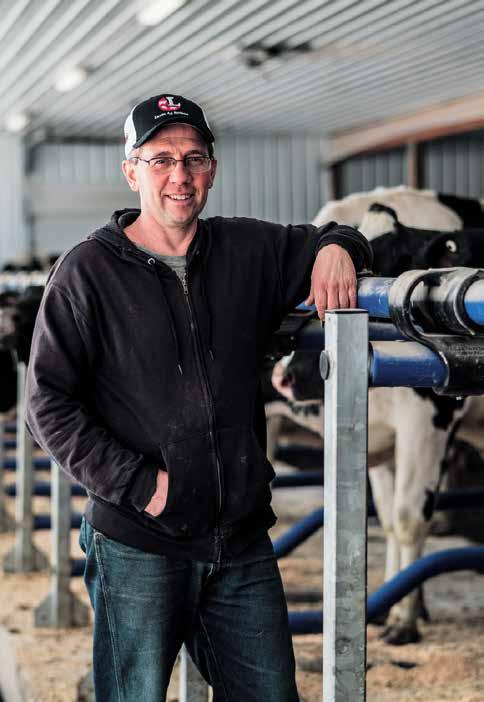
“The brewery is awesome, and I love my job, but my passion is here,” Jesse said.
The couple has two sons, Braxton and McCoy, and as they raise their boys, the Dorns are keeping the tradition alive at Kadence Farm. The Dorns especially appreciate the patient, docile temperament and gentle
heart of the Guernsey breed.
“They’re very good around our kids,” Jesse said.
If the Dorns had to pick one thing they love about the Guernsey breed perhaps more than the Guernsey herself, it would be the people. The Dorns host dairy judging teams from as far as California, and next year, they will be hosting the National Guernsey Convention.
“The people in our breed are one of the best parts about being a Guernsey breeder,” Jesse said. “They’re great, and they’re willing to share what they do to be successful.”
Kami agreed.
“At the convention, we all bring semen tanks and swap semen,” she said. “Guernsey people are the best, and we work together to better the whole breed. It’s about tradition. We love our Guernseys.”
Guernsey popularity is growing, as the Dorns have seen prices paid for these animals jump to new levels.
“The Guernsey market is high right now,” Kami said. “The last sale I went to animals averaged near $6,000 per head. At the Wisconsin Guernsey Association sale, calves averaged $3,000.”

The Dorns are excited to offer their rst consignment with their partners, Pond N Pines – a choice of March calves out of Nutter Butter – at the 1st Impressions at the Interstate III sale May 12 in Hagerstown, Maryland.
As they continue to develop quality Guernsey cattle, the Dorns feel privileged to work with the nest animals from three prexes.
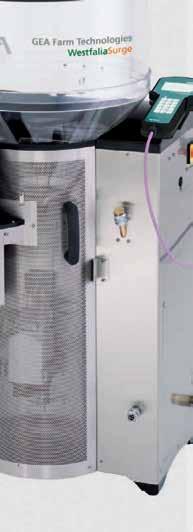


 By Stacey Smart stacey.s@dairystar.com
By Stacey Smart stacey.s@dairystar.com

BRODHEAD,






–When Emma Beutel was a little girl, she dreamed of owning a Jersey. That dream came true on Emma’s 7th birthday when her parents bought her rst calf – a Jersey named Fiona. Emma’s parents, Jim and Becky, continued to buy a Jersey calf for the next three birthdays that followed.

“I always wanted to be a farmer, and I’ve always been into cows, like my parents,” Emma said. “When they surprised me with a calf, I was like, I want more.”
Intrigued by the Jersey breed, Emma named her edgling herd Dandelion Jerseys – inspired by the little yellow ower she placed on Fiona’s head as a calf.
“Emma decided she liked Jerseys, and she had to have one,” Jim said. “I was more than happy to help her get started.”
With a re ignited inside, Emma aggressively built her herd. When she was 11, Emma branched into a new breed when she purchased her rst Holstein. And when she was 12 years old, she bought her rst Brown Swiss. Now, the 17-year-old has 50 head to her name.
“My mom always had Holsteins, my dad had Swiss, and I brought the Jerseys in,” Emma said. “Now, I’m growing in all three industries.”




Emma and her brother, Jack, and parents milk 70 cows in a tiestall barn at Walnut Crest Farm near Brodhead. Over 20 of those cows belong to Emma. Her herd includes 30 Jerseys, 15 Holsteins and ve Brown Swiss. All of her cattle are registered, and some are owned in partnership. Ten Jerseys, eight Holsteins and three Brown Swiss in her herd are milking, which includes a fair amount of mother-daughter pairs.
“I got a lot of help from





my mom and dad to grow my herd,” Emma said. “They helped me get into other breeds, too, and I’m happy that I have. The breeds are all very different and have unique personalities. You also get a different experience in the show ring from
breed to breed.”


Emma started milking cows when she was in third grade, and by the time she was in fth grade, she could milk on her own. Emma now milks starting at 5 a.m. and 5 p.m.

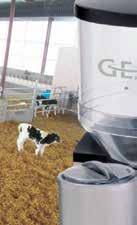


Emma’s grandparents
farm down the road and milk 40 Brown Swiss, and Emma milks cows at both places. The farms work in tandem with all cows calving in at Walnut Crest.

2013.

Jim’s family moved to Wisconsin in 1974 when urban sprawl pushed their farm out of the suburbs of Chicago.






“We have deep family roots in farming,” Jim said. “Our love for cattle, farm and family is why we chose to help Emma start out with her wish of having a herd of Jerseys. Emma has been an integral part of keeping everything going here.”
Emma shows at multiple county fairs, including Green County and Walworth County and two county fairs in Illinois – Lake County and Boone County – as well as World Dairy Expo in Madison. Emma shows all three breeds, but her proudest moment came last year when she won grand champion of the open show, FFA grand champion and showmanship at the Lake County Fair with her Jersey cow, Kalypso.
“I love working with animals, and I love going to shows,” Emma said. “When raising cattle, it’s kind of a surprise what you’re going to get. As a calf, she might not be the best looking, but then they turn into something you want them to be. It makes you feel really proud.”
Type is important to Emma, who likes to breed for show quality. To keep the heifers coming in her herd, Emma mainly uses sexed semen. Emma likes her black and whites big, and the towering Holsteins in the barn are indicative of what Emma and her parents like to breed for.
Emma has purchased Jerseys from the Top of the World Jersey Sale at World Dairy Expo as well as at the Dairyland Protein Sale held in Janesville during WDE. Mentors in the industry have helped Emma establish a successful herd, including people at the American Jersey Cattle Association.
“Emma started young and had a lot of people who helped her,” Becky said. “Everyone has been super good to her.”
The barn has seen a lot of Emma’s 2-year-old Jerseys calve in recently, including twins, Ava and Ada. Emma’s favorite cow is a
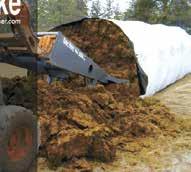
Brown Swiss named Fidget that she has shown for seven years.

“I think Emma has done a tremendous job,” Jim said. “She has animals that are nice to look at and also have good pedigrees. Her passion has helped invigorate me at times.”
Off the farm, Emma runs track and is also in FFA where she participates in dairy judging.
In addition, Emma is the current Brodhead Dairy Queen – a one-year term she started last June.
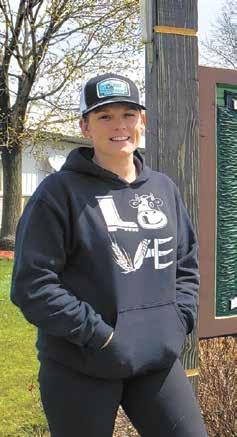
“I always looked up to the dairy queens,” she said. “I always wanted to be a princess and be a part of the community while promoting the dairy industry. I love talking to little kids and seeing they’re still interested in agriculture. I feel like so much is decreasing in the dairy industry, so it’s good to see that interest. There are kids who have never seen a cow or a farm before.”
Emma would also like to tie dairy into her senior project next year at school.
“I would like to get involved with the donate a calf program and help another youth get into Jerseys or give someone an opportunity to show who otherwise would not be able to,” Emma said. “I want to keep dairy going in the community.”
This high school junior is now looking to the future with plans of becoming a veterinary technician.
“I always wanted to be a veterinarian, but as I got older, I realized I would have to let all of this go in order to do that,” Emma said. “Being a vet tech, I could still work on the farm.”
Emma plans to sell approximately half of her herd to pay for college while keeping the farm’s future in the forefront of her mind and heart.
“After college, I want to go back into milking,” Emma said. “I would like to have a farmette and be able to sell 4-H calves. I want to keep the farm going in our family since it’s been in our family for so long. Someday, I want my kids to have an opportunity to say they were a farm kid too.”

“We like that the grooming brushes remove the winter hair and it keeps the cows cleaner and our parlor cleaner. The brushes are also easy to repair if necessary. Cows love them.”PHOTO SUBMITTED Emma Beutel, at age 7, is pictured with Dandelion Great Fire Rose Aug. 16, The Jersey calf was the rst calf to have Emma’s prex, Dandelion Jerseys.

Your Mixer, Spreader, Hay Processor Headquarters




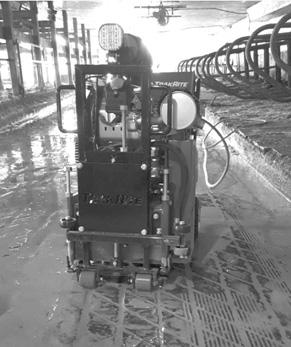
We carry:
Dana Berreau
507-879-3593 / 800-821-7092

Box 116, Lake Wilson, MN 56151



Teresa Hui did not grow up thinking of herself as an athlete. However, today at age 42, she is being featured in Milk Processor Education Program ads which spotlight women marathon runners.
“Through (MilkPEP), my biggest running dream came true: I was featured in “Runner’s World” magazine and appeared on a massive billboard in the heart of New York City,” Hui said. “I was overjoyed to bring my mom and husband to see it in person, and even my little sisters went to visit their big sister on the billboard by Penn Station, one of the busiest streets in the city.”
MilkPEP is funded by America’s dairy processors, which is governed by a nationally- represented processor board. MilkPEP is a consumer education program and the organization behind the Gonna Need Milk campaign – the 26.2 campaign is part of that campaign. The campaign aims to support and sponsor every woman running any marathon who signs up for #TeamMilk, but all current MilkPEP campaigns will feature women to boost attention on female athletes.
As part of the campaign, MilkPEP launched its Every Women Sponsored Fund in partnership with Girls on the Run International. Girls on the Run is an organization dedicated to empowering young girls through physical activity. For every woman who signs up for Team Milk, MilkPEP will pledge a donation to this fund with the goal of raising up to $1,000,000. This funding will enable the non-prot to enhance its curriculum to address the root causes of physical, social and emotional health inequities for girls and women.
“By actively supporting and empowering women, MilkPEP can play a crucial role in promoting gender equality and creating a more inclusive and equitable society,” said Yin Woon Rani, CEO for MilkPEP. “The pledge to feature only women across MilkPEP’s campaigns and partnership with
Girls on the Run is a step in the right direction to change the current narrative around women in sports.”
Only 5% of sports media coverage goes to women, Yin said.
“Over the past 30 years, there hasn’t been any signicant increase in women’s sports media coverage,” she said. “Everyone has a role to play in elevating the voices of women in sports.”
The campaign also celebrates the health benets of drinking milk.
“While this campaign focuses on women, dairy milk has performance and recovery benets for athletes and marathon runners, regardless of gender,” Yin said. “Not only does milk provide sustained energy to fuel your runs, the right 3:1 carb to protein ratio is ideal muscle refuel and recovery, and milk keeps you hydrated even better than water.”
For International Women’s Day, MilkPEP partnered with a diverse group of athletes, both current and retired, including Billie Jean King and Jordan Chiles. For 26.2 campaigns, female marathoners are specically highlighted.
Hui said she found out about the campaign from a fellow runner on Team Milk, Laurie Ann Sheppard.
“She knew how much I love running the New York City Marathon and that Marathon Sunday is my favorite day of the year,” Hui said. “She encouraged me to share my story with Milk, and it turned out to be a life-changing decision.”

After sponsoring women runners at the 2022 Marathon in New York City, MilkPEP will sponsor every woman running any marathon who signs up for Team Milk this year.
“The initiative will provide a spotlight for female runners’ journeys, along with female-centric training resources, nutritional advice, and mental and physical support from top sports experts,” Yin said. “(MilkPEP) aims to create a running community for women powered by women.”

The 26.2 campaign launched Nov. 6, 2022, at the New York City Marathon.
“When 26.2 launched in New York, over 3,500 women joining #TeamMilk … which raised an impressive $600,000 for Girls on the Run alone,” Yin said. “Women from 46 different states across the U.S. participated, showcasing the power of community and collective action.”
Hui is part of that community.
“When I started college, I decided to take up running as a way to lose weight,”
Hui said. “It was a tough challenge at rst. Running just half a block downhill left me out of breath and winded. But, I didn’t give up.”
She kept pushing herself, running a little further each time. Eventually, she was running miles.
“It was a major accomplishment for me, considering I used to think anyone who ran 2 miles a day was insane,” Hui said. “As I kept pushing myself, my mileage kept increasing until one Sunday I ran 18.54 miles on a long training run. My legs were sore, and I even got lost in a part of New Jersey I’d never heard of before.”
Hui ran her rst marathon, the NYC Marathon, in 2006.
“As I approached the last 3 miles of the race and saw the mile markers

in Central Park, I found myself crying tears,” Hui said. “It wasn’t because I was exhausted, but because I realized that the girl who once thought she could never run more than 2 miles was now nishing 26.2 miles in the largest marathon in the world.”
Besides now loving running and wanting to share her story through the campaign, Hui said she loves milk and feels good about promoting it.
“It was seriously the perfect campaign to be a part of and combined my favorite things in the world – marathons and milk,” Hui said. “When I was a kid, my grandma would take me to the bodega every week to get a half gallon of milk, and I would sometimes nish it so quickly she would have to go right back. We would go on long walks together and come back for a cold glass of milk. It hit the spot like nothing else. Today, I still drink milk to fuel my runs, and I look forward to my refreshing chocolate milk after a long run.”
Enthusiasm for running, the 26.2 campaign and drinking milk are helping to keep Hui in the race.
“Now that I’m 42, I’m a lot slower than I was when I was in my 20s, but I plan on continuing to run the New York City Marathon until I can no longer move my body,” Hui said. “I want to be that 100-year-old lady on the course that everyone cheers on. … And, after I take the subway back home from Central Park, there will be a glass of cold chocolate milk waiting for me to help my body recover.”


How many years have you been a director for DHIA? I was rst elected to the local board in Benton County in 1991 and served for 15 years; I was president for 10 years. In 2002, I was elected to the Minnesota DHIA board. I have served as president for the last nine years. I have also served on the National DHIA board for the last 10 years. I serve as treasurer.
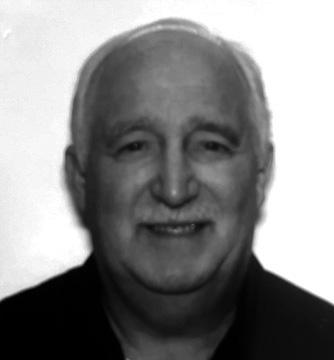
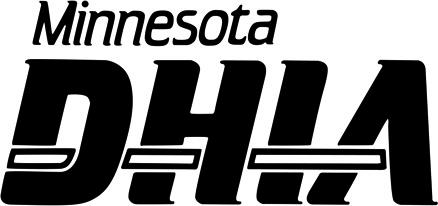
What are some of your duties as director? Making sure that we are nancially sound, competitive and ef cient. We work to keep DHIA affordable, accurate, and timely for management decisions for your farm.
What do you like about this role? As president of the board, I enjoy working with good board members who all give a lot of insight into the future of DHIA. Also working with Bruce and the staff make my role as president an easier job.
Why is DHIA important to you? DHIA is a very important management tool to us and our consultants for making good decisions. We use PCDART software to keep track of herd information on our farm. Nutritionists look at it monthly or more depending on ration changes. PCDART also works with our activity monitoring system. We are a big user of the milk pregnancy test. Preg tests are taken every test day and in between tests. It is a big labor saver. The somatic cell count list is watched closely. We either cull or treat high cows. The treated waste milk is pasteurized for calves.
Tell us a about your farm. The farm – Scapanski Farms LLC – is a partnership with my two sons, Chad and Brad. We are a diversi ed farm. In addition to the dairy herd, we raise all of our heifers, feed our steers and farm 1,100 acres for feed and to sell. We also do custom chopping, planting and combining.

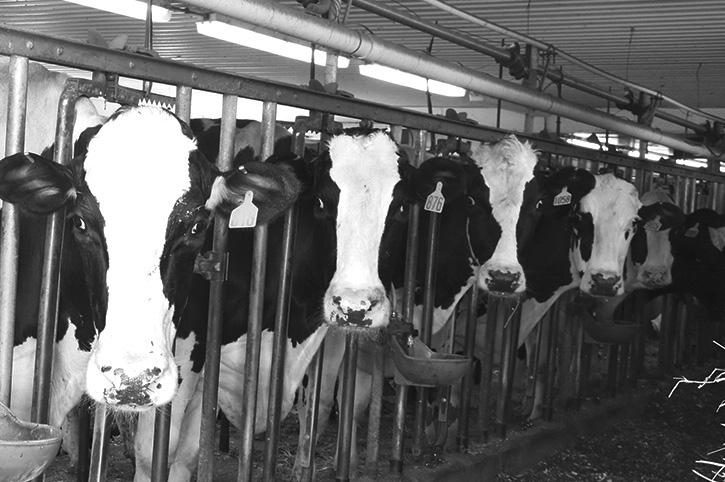
CIH 8950 1,600 hours ..........................$165,000
CIH 8910, 2WD, 4,100 hrs .........................$72,000

CIH 8920, FWA, 4,400 hrs. ....................$79,000
CIH 7240, 2,500 hours, coming in ...........$110,000
CIH 7230 Magnum, 5,000 hrs., sharp ....$85,000
CIH 7140, 5,900 hrs., FWA ....................$75,000
CIH 7120, FWA, 2800 hrs. .....................Coming In

CIH MX120 ............................................Coming In
IH 1466 restored, new 20.4x38 Firestones$38,000
IH 1456, cab ..............................................$22,000
IH 1086 w/no cab .......................................$18,000
IH 806 ....................................................$11,000
TILLAGE
CIH 527B ripper .....................................$13,500
CIH 6750, 4 shank, 3 twist w/lever.........$15,500
CIH 530B................................................$18,000
CIH 870 7-shank ....................................$38,000

CIH Tigermate II, 26’ ..............................$28,000
CIH Tigermate II, 26’ w/rolling basket ....$32,000
CIH Tigermate 200, 30’ ..........................$44,000
CIH Tigermate 200, 28’ w/rolling basket$40,000
CIH Tigermate 200, 32’, w/4 bar drag ....$33,000
$5,000



Many Sizes of Gravity Boxes ..................on Hand Brent 657 gravity box, green & black, fenders ................................................$23,000
(2) Brent 644 box .......................................$18,000
Brent 644 ...................................................$16,500
J&M 385 ......................................................$6,500
J&M 540 box .............................................$13,500
Parker 4800 box...........................................$8,500
Unverferth 7250 grain cart .........................$29,500
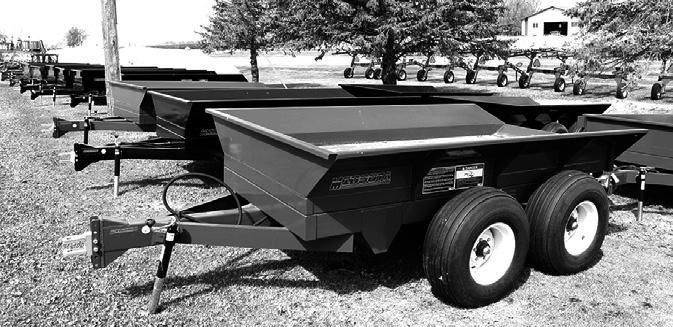

MISCELLANEOUS
New Red Devil & Agro Trend Snowblowers
Hagedorn 3290 Hydraspread spreader ..$36,000
USED SNOW BLOWERS
Schweis 8’................................................$1,000

 By Tiffany Klaphake tiffany.k@dairystar.com
By Tiffany Klaphake tiffany.k@dairystar.com




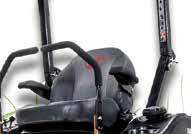






– The smell of fresh cheesecake, crushed graham cracker and raspberry wafts in the air at Christine’s Cheesecake in Waite Park.
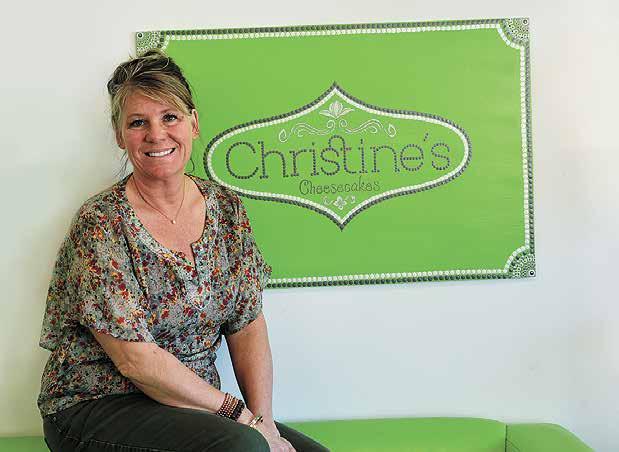
Over 30 varieties of cheesecake are set out at Christine Skoog’s display case for customers to bring home and enjoy on a daily basis.
“I have always made cheesecake for friends, family and potlucks,” Skoog said. “It’s always been a passion of mine.”
When Skoog rst started selling cheesecakes, she made them in a commercial kitchen and drove around in her minivan, stopping at various businesses to sell to the business or the people working there.
“I’m unique in this area because I only do cheesecake,” Skoog said. “When I rst opened, I had people ask me if I think I can sustain a business with only having cheesecake. I said, ‘If my cheesecake is re-


ally good, I can.’”

Skoog makes her creations in 9-inch and 19- by 11-inch pans. The larger pans are used to portion out mini cheesecakes.
Skoog buys cream cheese in 30-pound blocks and uses 15 pounds to make two sheetcake pans of cheesecake. The


oven at Skoog’s current location can hold six sheet-cake pans at one time. On days when Skoog bakes, she makes 18 sheet cakes or 20 9-inch round cheesecakes.
Skoog uses 360 pounds of cream cheese and a couple pallets of sugar every two weeks to craft her creations.
Making cheesecake was always a passion of Skoog’s but did not turn into a business until 2012. At the time, she was raising four children while working as a server at a restaurant. She offered to make the cheesecake for the staff Christmas party, which led to making cheesecake for the restaurant
itself.
“After a couple of months, they told me I really should start my own business,” Skoog said. “I said I didn’t know how to run a business, and they said, ‘You are a smart girl; you can gure it out.’”
The turning point for Skoog happened when she was waiting on one of the regular customers at the restaurant.
“I told her my dream as I did many other people,” Skoog said. “She just believed in me and wrote me a check to start my business. Dreams do come true.”
Skoog talked with her sister-in-law and came up with a name and color scheme. Skoog knew of a commercial kitchen available, and although it did not have a store front, it would work.
“Six weeks later, I was in full-edged business,” Skoog said. “God is great all the time; every stepping stone creates a path that guides us.”
Skoog has continued to pay back the woman who helped her, and just this month, she was able to write the nal check.


Skoog also likes paying it forward in her community. Later this spring, she will participate in a fundraiser to raise money for the Tanner’s Team Foundation.

Looking ahead, Skoog has lots of ideas, such as taking her cheesecake to the Minnesota State Fair, but she wants see the last of her children graduate from college rst and then hopes to expand to more locations.

“I would love to have many more of Christine’s Cheesecakes and for it to be all over the U.S., but that takes time,” Skoog said.
Turtle and white chocolate raspberry remain the best sellers at Christine’s Cheesecakes, but she has a list of over 200 types she can make. She uses the same recipe as her base that she used while she was growing up and baking with her mom and grandmother. Then, she uses various ingredients to make the avor combinations. Skoog said at rst it was a lot of trial and error, but now, it is much easier to create a new avor.
“Now that I am familiar with avors and different ingredients, I can get a pretty good idea what a avor will need,” Skoog said.


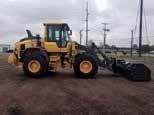

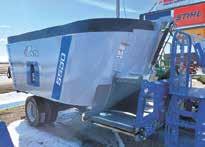
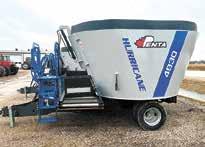
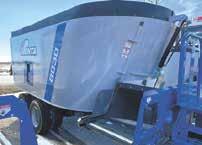


Special events such as weddings and showers as well as going to local fairs and festivals on top of the usual holidays keep Christine’s Cheesecakes busy year-round.

Skoog is not afraid to try something new and takes requests if there is a avor not on her list that a customer would like to have.


Chris�ne Skoog cuts into a 30-pound block of cream cheese April 12 in Waite Park, Minnesota. Skoog purchases 360 pounds of cream cheese every two weeks for her cheesecake business.

“I had a wedding one time that wanted black licorice cheesecake,” Skoog said. “I do not like black licorice, but they absolutely loved it and their whole family went crazy for it.”
Being a one-woman show, Skoog has learned how to run a business in the last 12 years. She has proven the skeptics wrong that it is possible to run a business selling only cheesecake.
“When you have a dream and it comes to fruition, it is just magical,” Skoog said. “It’s powerful.”








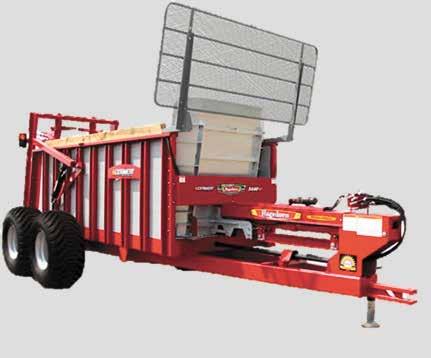
























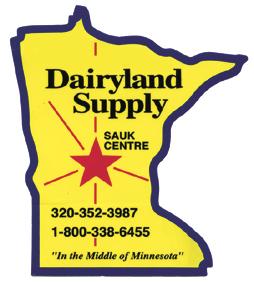
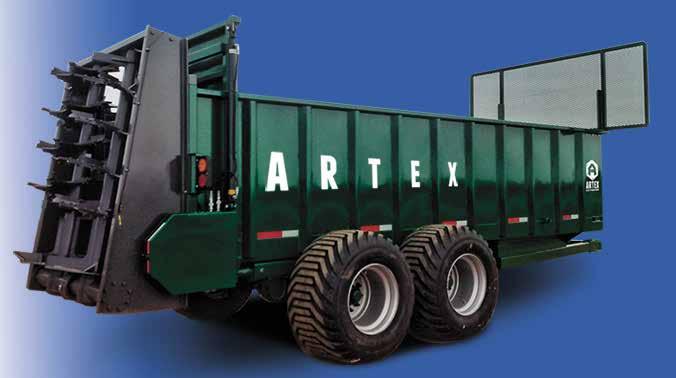

 Dave Brekken Edgerton, Wisconsin Dane County
Dave Brekken Edgerton, Wisconsin Dane County
When did you start and nish your dairy career? We moved to our farm in 1960 when I was 10 years old. My dad died in 1967, and then I farmed with my mother and brother for a couple years. I took a break from farming and tried factory work for a little while, but I didn’t like it. I then got back into farming when my father-in-law sold his herd to me. I ended up selling my cows 23 years ago.
Tell us about your farm when you milked cows. I milked around 50 cows in a stanchion barn and farmed 200 acres on the farm where I grew up, which I bought from my mother.


Who and when do you help on the farm? I help my son, Cory, who milks close to 80 cows near McFarland, Wisconsin. He is visually handicapped, so I have been helping him every day ever since I quit farming.
What are some of your different duties? I help with milking and eldwork, including planting, cutting hay and baling hay.
What do you enjoy most about helping with eldwork? I kind of like a little of everything. We do a lot of hay, and basically, I just like doing eldwork.

What has been your best experience helping or your favorite time of year to help and your role within that? Helping Cory on the farm is my hobby. I don’t take much time off, and I don’t really have any other hobbies. Cory follows a seasonal calving schedule that starts at the beginning of March and goes through April. Watching all the calves be born is exciting, but it’s also kind of a chore. We have to check on anyone that’s freshening, and we’ll typically have ve or six cows freshen every day.
What is a piece of equipment you operate now that you wish you had for your dairy career? When I farmed, I lled silo, while Cory does everything with a round baler to make dry hay and silage bales. It works good for his situation. Filling silo wasn’t a bad thing, but he’s making more money doing it this way. I was running an unloader and had a Harvestore, and they’re expensive to operate.
When you look at the current state of the dairy industry, what are your thoughts and concerns? I’m concerned that dairy farmers don’t get enough money. When I quit farming, we were paid $17 per hundredweight, and it’s not that much higher now.

What do you do in your spare time? I have a honeydo list when I get home, and I also like to play the card game, Euchre – I do that about three times a week. I x and repair stuff around the house when I have time, and I also help my daughter and son-in-law at their place.



When did you start and nish your dairy career? I started dairy farming right out of high school in 1972. The 1980s were rough so I decided to sell out in 1985. Following my auction, I got an entrylevel job in our local highway department. I got a commercial driver’s license and also relief milk hauled to Sanna Dairies in Menomonie, Wisconsin. Tell us about your farm when you milked cows. My farm consisted of 240 acres, and on average, I milked 60 cows.
Who and when do you help on the farm? I help my neighbor, Mark Harnisch, a crop farmer, by trucking corn in the fall to his dryer.
What are some of your different duties? My duties consist of driving semi, unloading it at the dryer and taking random samples to check for moisture level.
What do you enjoy most about helping with eldwork? I most enjoy the camaraderie of helping Mark, his wife and kids to get their fall harvest in.
What has been your best experience helping or your favorite time of year to help and your role within that? My favorite time of the year is the fall harvest and getting the crops in before the snow.
What is a piece of equipment you operate now that you wish you had for your dairy career? Nothing really comes to mind.
When you look at the current state of the dairy industry, what are your thoughts and concerns? My concern with the dairy industry is the loss of small and mid-size farms. All it’s going to take is one tornado or a mass disease to wipe out a large operation and thereby impact the milk and cheese supply in the stores.
What do you do in your spare time? I am retired now. I keep busy with attending my grandkids’ sports activities, doing woodworking, welding and stain glass in my shop. My wife and I enjoy motorcycle riding (she has her own cycle). Last year was my rst time to go to Sturgis, South Dakota, with a group of guys who have gone prior years. What I’d like to say to those who are struggling on their farms is that even though one may truly miss farming, there is life beyond the farm. You’ve got to branch out and explore new things, and you will nd happiness beyond the farm.
Star Blends has been helping Midwest farm families by providing, high-quality feed, dairy nutrition, and commodity contracting for more than 20 years.

Our state of the art mill can accuratelyblend anything from a custom pre-mix to complete feed, in balancing diets, or work with your private nutritionist or dairy consultant.
Jim Bell Camp Douglas, Wisconsin Juneau County
When did you start and nish your dairy career? I started in 1961, and in 1999, we moved to where my son lives now. In the last 5-10 years, I’ve stepped away from milking.
Tell us about your farm when you milked cows. When I started farming, the farm I took over didn’t have many stalls. There were a few Guernsey farms. Building wise, it was in bad shape. When we moved to the new farm in 1999, we were milking 60 cows and had a Harvestore for high-moisture corn. We had three other silos for corn silage haylage.
Who and when do you help on the farm? I help my son, Tim, every day.
What are some of your different duties? Fieldwork, bookwork and mixing feed. If a problem comes up, I can go help with whatever it is too.
What do you enjoy most about helping with eldwork? Getting out in the open.
What has been your best experience helping or your favorite time of year to help and your role within that? I don’t have a favorite time of year. They’re all good. In Wisconsin, you’ve got the ability to have change every so often.
What is a piece of equipment you operate now that you wish you had for your dairy career? Anything that was a big tractor back then is a toy now. When I started, I was on an 80-acre farm, and now we own over 1,200 acres. I prefer the old-fashioned stuff.
When you look at the current state of the dairy industry, what are your thoughts and concerns? It’s sad that we’ve kind of forced the little farmer out. Even a 600- to 700-cow dairy is no longer considered big. Back when I started, you never heard of anyone that big, but now, there are farms in the thousands. I would hate to have to manage one that big.
What do you do in your spare time? Go to church on Sunday. That’s one day all through my life I’ve tried to respect. My parents taught me that, and I respect it to this day.

When did you start and nish your dairy career? I was the third generation in my family to dairy farm. I started on a tractor when I was 8 years old. All I ever wanted to do was farm. My daughter and nephews took over the operation about three years ago.
Tell us about your farm when you milked cows. I bought the farm I started on in 1963. My dad mortgaged the cows for the down payment. We milked cows with bucket milkers. Once I got married, my wife carried milk for me in the morning and fed calves before she went to work. We bought the farm on the ridge in 1970. When my younger brother returned from Vietnam, we incorporated the two farms and added another farm. We milked 40 cows on each farm until the mid1970s when we combined the herds and built an auto ow parlor. Now, they milk 200 cows.
Who and when do you help on the farm? I help my daughter and nephews on most days.
What are some of your different duties? I help wash down the parlor when they are done milking, haul bales with the tractor and wagon, and get supplies on Saturdays.
Edward Andreas Brodhead, Wisconsin Green County
When did you start and nish your dairy career? I started around 1968 and sold the cows in 1992. Tell us about your farm when you milked cows. We usually milked around 70 to 80 cows, but at times, it was a lot more. We farmed 352 acres, and it was some pretty nice, productive land. We also rented about 45 to 50 acres that was not as good of land but grew good alfalfa. We had three rows of stalls in our stanchion barn and two barn cleaners along with calf pens and maternity pens. We switched over to a freestall barn in the late 1980s, but we kept milking in the stanchion barn. The farm also had a cattle shed divided up for dry cows, milking cows that preferred it over the free stalls and youngstock. Our farm had ve silos – two for high-moisture grain and three for alfalfa and corn silage. We also had another farm up the road for extra cattle. We did all A.I. breeding and tested with the Dairy Herd Improvement Association. We had Holsteins, and there were some big cattle in our barn. We had some pretty good cows.

Who and when do you help on the farm? I help my daughter and son-inlaw, Becky and Jim Beutel, pretty much from spring through fall. They milk 70 cows near Brodhead, Wisconsin.
What are some of your different duties? I help with eldwork – hauling corn silage and haylage and cutting and raking hay. I also haul and spread manure. I usually cut and rake most of the hay. I like to lay it out wider so we can bale it and then wrap it. It seems like the weather doesn’t cooperate when you cut alfalfa, but this way, you can have more moisture. I also chop and bale cornstalks.
What do you enjoy most about helping with eldwork? I was 15 when I rst planted corn, and I enjoyed that for many years. I don’t do that anymore. I enjoy just being able to help them.

What has been your best experience helping or your favorite time of year to help and your role within that? If they’ve got a part that they need, I can go get it for them because I don’t have to be back for milking at a certain time. They know how to get milk out of cows. I am proud of them; they’re doing a good job.
What is a piece of equipment you operate now that you wish you had for your dairy career? They’ve got a sidehill combine now and that is nice because some land around here is pretty steep. I like to tell people that we farm both sides.

When you look at the current state of the dairy industry, what are your thoughts and concerns? People do not appreciate where their food comes from. And when people talk about greenhouse gasses and blame it on cow farts and burps, I just can’t gure out what they are thinking.
What do you do in your spare time? I go golng with two of my friends on Thursdays. I am in my 80s, and I met one of them in elementary school and the other one in high school on the bus. We are now three retired dairy farmers so on Thursdays, we golf.
What do you enjoy most about helping with eldwork? Getting it done. Jim and Becky farm close to 1,000 acres, and it’s satisfying to complete all the work. I’m also happy when the alfalfa doesn’t get rained on.
What has been your best experience helping or your favorite time of year to help and your role within that? I like helping once the snow is gone until it comes again. I would prefer to stay home when the snow is ying. But you never know, if the phone rings, you go. I enjoy it. It’s something to do and is better than sitting at home.
What is a piece of equipment you operate now that you wish you had for your dairy career? The big square baler, but we hire it done because it costs too much to buy that equipment. The discbine is the thing I really like. I had an old haybine with sickles, and it can drive you nuts. The discbine goes a heck of a lot faster. You can get a lot more cut in short order, but you can still have problems too.
When you look at the current state of the dairy industry, what are your thoughts and concerns? With the price of milk, feed, equipment and extra labor, I don’t know how some of these guys make it. You have to be pretty tight. Of course, it wasn’t much better when we were milking – it was tight also. To balance it out, you have to be milking roughly 100 cows and running quite a few acres and hopefully sell some soybeans and corn and maybe some hay too. You have to have something to help because there’s always something going wrong on the farm.
What do you do in your spare time? I am a Vietnam veteran, and I belong to a Vietnam veterans group. We have meetings and try to raise money to help the community. I also belong to Veterans of Foreign Wars. I belong to ve or six different organizations like this, which helps keep me occupied.
















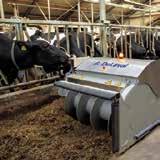
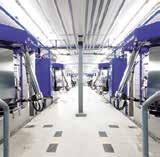


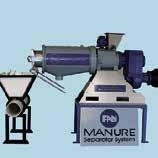



Describe your facilities and list your breeding management team. We have a crossventilated, 6-row robotic freestall barn with headlocks and a loose housing pole shed for the breeding age heifers. We have a small pen with a chute next to the heifer sheds.

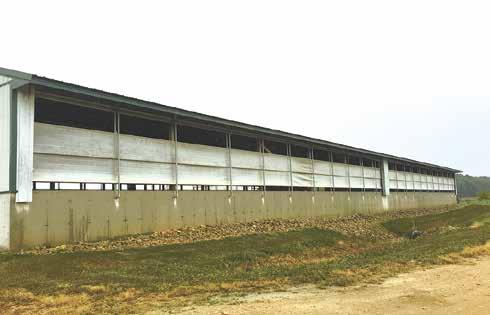
Ben and I decide on the group of bulls we’re going to use with Ben doing most of the individual day-to-day breeding decisions. We use bulls from multiple studs.
What is your current pregnancy rate? It is usually around 35%.
What is your reproduction program? All the cows wear activity monitors and show up on the computer as a percentage of possible heat based on activity. Our voluntary waiting period is 70 days in milk. We use ovsynch on the cows that haven’t shown a heat by 90 DIM and cows that are conrmed open. All the heifers are caught in heat visually.
Describe your breeding philosophy. We’re trying to breed balanced cattle with good feet and legs and especially health traits and components. In more detail, we breed our virgin heif-

Steven and Julie Middendorf, and their son, Ben Sauk Centre, Minnesota | Stearns County | 200 cows

ers to sexed semen and about 25% of the top milking cows to sexed semen and the rest of the herd to beef bulls. We use mostly Angus and SimAngus.

What guidelines do you follow to reach the goals for your breeding program? Ben and I usually sit down and se-



lect a group of bulls that match our criteria and price. We usually do this after each proof run.

What are the top traits you look for in breeding your dairy herd and how has this changed since you started farming? Priorities certainly have changed over the years.

We’ve been selecting for high component bulls for the last 10 to 15 years, but since we went to the freestall barn, we’re watching feet and legs closer. With the robots, a few new Turn






“Udder Comfort™ is a product that has proven itself at our farm for at least 15 years. It is the one that works, so we make sure it’s always in the barn. My mom likes to rub it in and prefers the white lotion because it is thicker. When putting it on a hard quarter, it goes right down,” says Shelby Biasini. Shelby and Adele help their mom Debora milk 40 cows near Morrisville, Vermont. Their dad Stan makes the cheese. They show at Big E, Harrisburg, Madison and Louisville. During and after bagging, they use Udder Comfort.



“We also put Udder Comfort on udders and belly area daily for a week before calving and continue 2x/day as needed after calving. It takes edema out much faster than anything else,” she explains.





“Cows come into milk faster with softer udders. You can’t be random about it. Using it regularly, we don’t see mastitis issues, and our milk quality is always among the top herds in Vermont.


traits are being bred for like teat length, teat placement and milking speed.
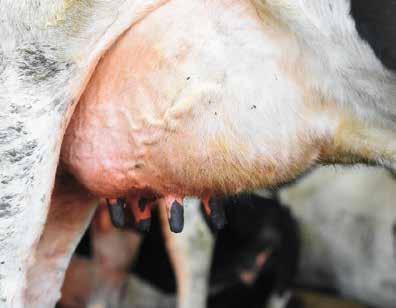
What are certain traits you try to avoid? The traits we are avoiding are really short teats, close rear teat placement and slow milking speed. We also don’t like small cows, so we try to select bulls that are average size.
Describe the ideal cow for your herd. A 1,400-pound cow with a decent udder and feet and legs to handle the concrete. It’s a plus if they have a high IQ.
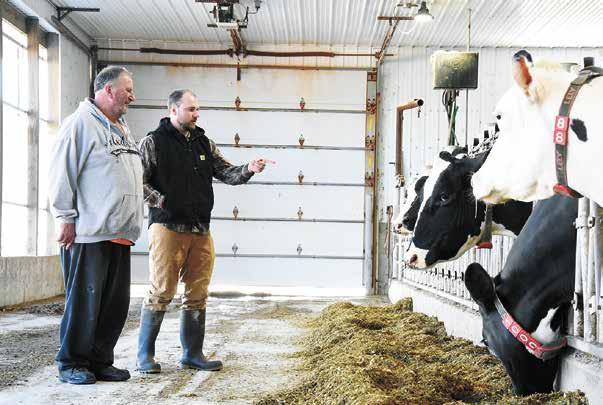
What role does genetics have in reaching the goals of your farm? We think genetics is very important, and we try to be diligent about the bulls we use. Everytime you breed a cow or heifer, there’s a good chance you’re getting a better cow than you have.
What percentage of your herd is bred to sexed, conventional and beef semen? We use sexed semen on all the heifers and the top 25% of the milking herd, and we use beef semen on the remaining of the milking herd.
The Middendorfs breed for teat length and placement as well as milking speed. They milk with three robo c milking systems.
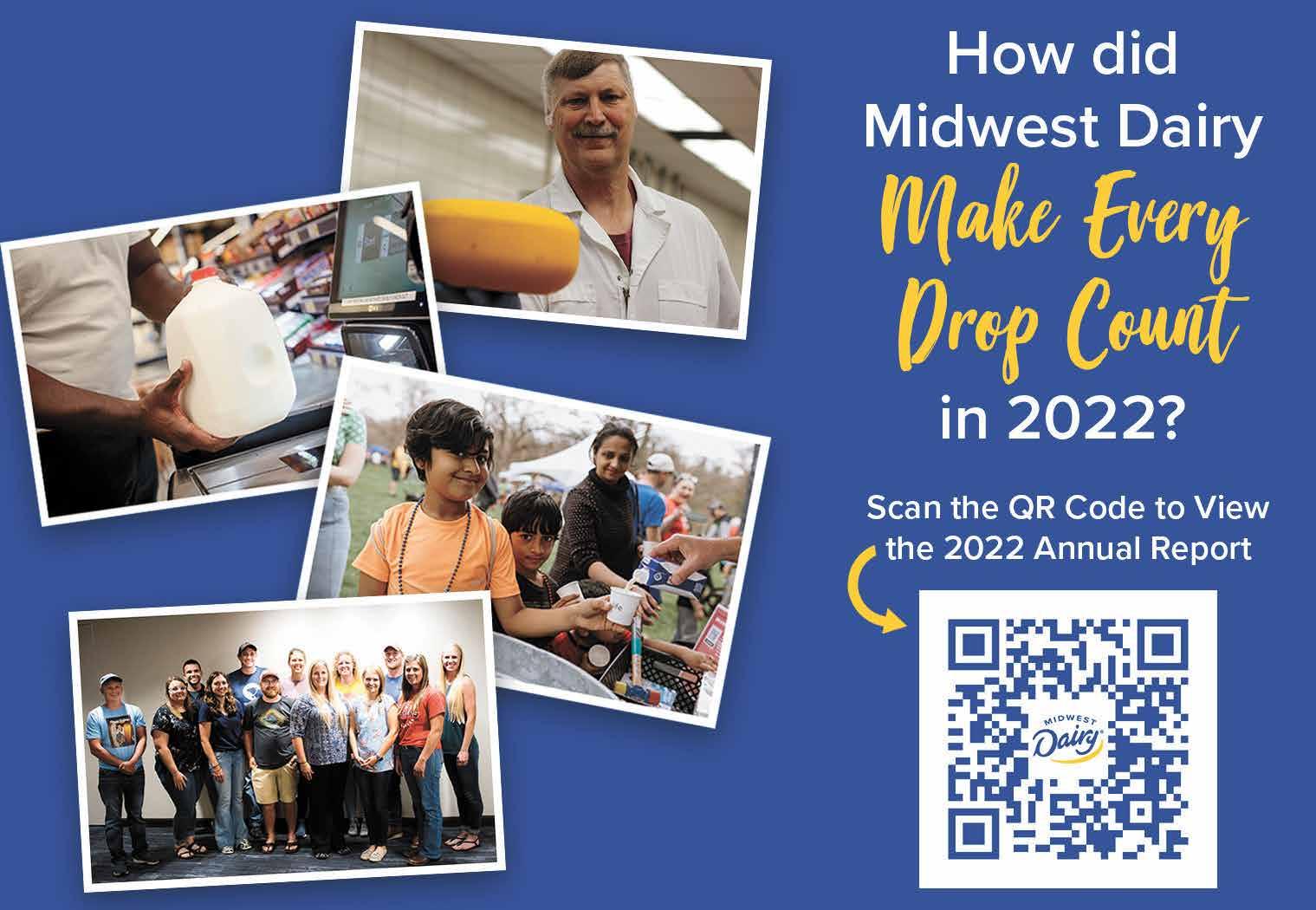
What is your conception rate? How does this differ with different types of semen? Our conception rate is about 50%. In our experience, sexed semen settles as well as conventional Holstein semen, and beef semen lags behind just a little. That being said, we’re also breeding the harder settlers to beef semen.
What is the greatest lesson you have learned through your breeding program? My biggest lesson might be that
as much as I’ve tried to learn about breeding and genetics, my expertise is only scratching the surface of the vast array of information.
What is the age of your heifers at rst service? We aim for 15 months.
How does your heifer inventory affect your breeding program? Very little. We always seem to have enough heifers in the pens. We try not to raise extras because it’s too expensive.
Tell us about your farm. We have a 170-stall freestall barn with three robotic milking systems. Our son, Ben, is the herdsman and takes care of fetch cows, treating sick cows and most of the breeding. My wife, Julie, is the calf raiser, and I do most of the feeding and bedding and manure management. We have 500 acres of corn, alfalfa and soybeans.
.. $39,900




JD 2210 2010, 35.5 ft., 3-Section Folding, #559584 ...................... $40,000
Case IH TIGERMATE 200 2012, 60 ft., 5-Section Folding, #556196$45,900
JD 2210 2010, 57 ft., 5-Section Folding, #542886 ......................... $47,900


Case IH 200 2014, 60 ft., 5-Section Folding, #554255 ................... $52,500
JD 2210 LL 2014, 45.5 ft., 5-Section Folding, #559823 ................. $54,900
JD 2230FH 2021, 44 ft., 5-Section Folding, #554071................... $129,000
JD 2230 2019, 60.5 ft., 5-Section Folding, #558064 .................... $134,500
JD 2230 2019, 60.5 ft., 5-Section Folding, #558065 .................... $134,900

JD 2230 2022, 44 ft., 5-Section Folding, #559697 ....................... $151,000

JD 2230 2022, 60 ft., 5-Section Folding, #553589 ........................




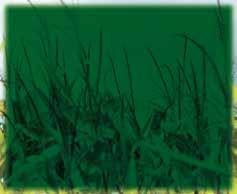








PTO, 236 hrs., #547879 .... $89,700






JD 6430 2011, Cab, MFWD, 540/1000 PTO, 578 hrs., #549141 ........$89,900
JD 5115M 2022, Cab, MFWD, 540/1000 PTO, 48 hrs., #547523 ...... $98,300
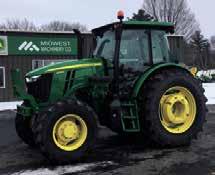


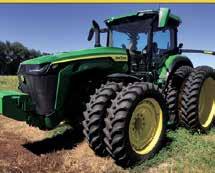


JD 5115M 2022, Cab, MFWD, 540/1000 PTO, 4 hrs., #547343 ........ $98,300
JD 5125M 2022, Cab, MFWD, 540 PTO, 250 hrs., #273316 ........... $104,900
JD 5125R 2018, Cab, MFWD, 1000 PTO, 320 hrs., #559038 .......... $104,900
JD 5115R 2022, Cab, MFWD, 1000 PTO, 245 hrs., #547562 .......... $109,500

JD 6130M 2022, Cab, MFWD, 540/1000 PTO, 580 hrs., #554855 .. $134,900
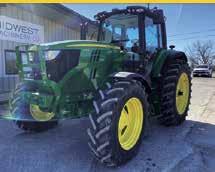





JD 6130M 2022, Cab, MFWD, 540/1000 PTO, 169 hrs., #181603 .. $145,500
JD 6130M 2022, Cab, MFWD, 540/1000 PTO, 150 hrs., #273313 .. $148,500
JD 6120M 2021, Cab, MFWD w/ Suspension, 540/1000 PTO, 270 hrs., #272630 ........................................................................ $150,900
JD 6120M 2021, Cab, MFWD w/ Suspension, 540/1000 PTO, 150 hrs., #271072 ........................................................................ $152,200
JD 6120M 2022, Cab, MFWD w/ Suspension, 540/1000 PTO, 2 50 hrs., #273315 .......................................................................... $165,900
6120M 2022, Cab, MFWD w/ Suspension, 540/1000 PTO,





































































































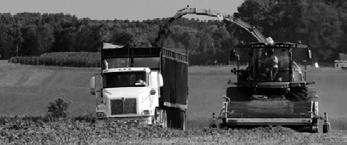






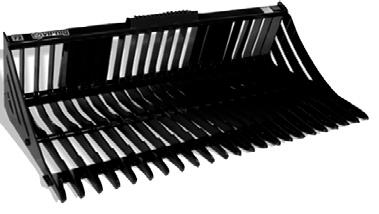





SIREN, Wis. – Fifteen months is a long time.

During that span, lives can become altered and warped with a gamut of emotions.

Adam and Annie Hedlund and their young family know this to be true.
The Hedlunds milk 100 cows near Siren in Polk County, where they ship their milk to the Burnett Dairy Cooperative.


After a 15-month journey suffering and recovering from coronavirusinduced pneumonia, Jan. 11 marked the day of homecoming for Adam, who was in three hospitals in three corners of the state.
Adam had been admitted to the hospital in Amery Oct. 11, 2021, for complications from COVID-19. Doctors there determined he required a ventilator which prompted his transfer to a Minocqua hospital, where the nearest intensive care unit bed was available.
There, his health continued to deteriorate, and on Oct. 23, 2021, doctors decided he should be sent to Froedtert Hospital in Milwaukee, where he
would remain for over a year as an ICU patient for most of his stay.
Once he arrived in Milwaukee, Adam was placed on an extracorporeal membrane oxygenation machine, which oxygenated his blood outside of his body. He remained on the ECMO for six months. Adam was placed under sedation for much of November and December. By January 2022, the doctors determined the only way Adam would leave the hospital alive was with a double lung transplant.
Adam began the arduous task of grueling physical therapy to strengthen his body as much as possible in preparation for a transplant. By March, the doctors felt he was strong enough to undergo the procedure, and he was placed on the transplant list.
Adam received the gift of life in the form of two lungs April 5, 2022. However, the trauma to his chest cavity was so great that one of his new lungs became damaged from the bleeding and scar tissue. He was relisted for another right lung, which he received April 23, 2022 and was nally removed from the ECMO machine.
During all of this, Annie worked to keep their farm going with help from family and neighbors and to care for their two young daughters who did not understand where their dad had gone. Annie, at the time, was also carrying the couple’s third child. Their son was born in May 2022, just weeks after his father’s life-saving transplants.

For the next eight months, Adam continued to work toward being home.


Summary: This proposal seeks to eliminate all undercutting in the marketplace by milk handlers and the resulting race to the bottom in farm milk pricing through “reblends”, “market adjustments”, pooling on distant Federal Milk Marketing Orders, and de-pooling. In return for this mandate on handlers, farmers will only supply the market with milk that is needed.
De nition of milk handler for this document: 1.Any party that is buying milk from any farm or collectively from a number of farms 2. Any party that is buying raw or un nished milk components that require additional processing before they are ready for retail from a dairy plant
This proposal will be implemented by the Federal Milk Marketing Order in which the milk is produced. If a milk handler is in a region not covered by a FMMO, rates will be set by the closest order to the plants location.
The Class I milk price will go back to the higher of the advanced Class 3 or Class 4 milk price.
All milk handlers shall pay all producers the Federal Order price on all milk components shipped by producer.
Any milk handler paying producers on a base price plus components are not allowed to deduct from components a higher rate than the federal order value of said component. The base price formula will be paid on 3.5% butter fat, 3.0% protein, and 5.6% other solids.
Make allowance for processors should be passed on to consumers and not deducted from farmers.
All milk handlers will pay federal order rates on milk or separated milk components purchased from any other milk handler. All separated milk component buyers will give 7 day notice to milk component sellers of an oversupply of component before lowering amounts of components purchased.
PPD must be paid at Federal Order rate. Handler may subtract any zone differential and fees charged by order.
All milk will be pooled in the Federal Order of where it was produced. No exceptions--Even on milk moved to and sold in an Order other than where it was produced.
Grade B milk shall be paid at Federal Order minimums with no PPD.
All milk handlers have the authority to balance their milk supply by disposing an equal percentage of milk on all of their farms. Farms will be noti ed by handler at least seven days prior to this action and at what percent of a baseline production needs to be reduced and for how long. Farmers must make this reduction by dumping (or not producing) raw milk at the farm. This milk may be used for animal feed or must be disposed of in a sanitary manner. Milk hauler will have the authority to release milk to accomplish desired production. Farmers are not allowed to turn off cooling tank and let milk separate and release only skim milk. Farmers lling directly into tankers will be responsible for the disposal of milk by obtaining scale or meter tickets when tanker is unloaded. Milk handler may let direct ship loads meet their disposal amount by extending the period for one week to allow for complications that may arise from not being able to be weighed on the farm.
Farmers’ milk production can be based off the previous month or the same month from the previous year in case of seasonal freshening, grazing or on farm event that signicantly lowered production for the previous month.
Dairy plants may allow for new producers and/or expansions as their market determine the need.
Milk hauling rates assessed by milk handler on producer will be assessed on a per hundred weight basis and may have a dollar amount cap per month. Hauling rates may not be used to discriminate against producers due to size or distance. Hauling rates may be adjusted from time to time due to increased cost of operating trucks. Hauling cost may not exceed actual cost by more than ten percent. Any hauling over charges must be refunded to producer as decided by the Order. Milk Marketing Order shall allow co-mingling of milk among handlers to make transportation as ef cient as possible.
Milk handler will notify Federal Order of this action so Federal Order may audit milk handlers’ farm records to ensure equal treatment of farms during their routine audits.
All milk handlers buying milk from another milk handler will give that milk handler a 45 day notice of changes to amount of milk they will accept during a Holiday schedule or a planned plant shut down.
In the event of an emergency plant shut down where milk cannot be processed and must be moved to another plant the Federal Order will oversee the transportation cost and may allow lower prices to be paid on this type distressed milk in the event that milk supply is long and milk is not needed at other plants.
After 13 months, he was taken out of ICU and placed into a regular hospital room. Then, he was moved to an in-patient rehabilitation facility for two weeks and was in out-patient care for two weeks before nally making his way home.
“There has denitely been some adjusting, physically and emotionally,” Adam said. “It’s been a big change, but I can feel that I am constantly getting better.”
The Hedlunds said their daughters – Azra and Analiese
started out shy around their dad but warmed up quickly while Atlas fast became his dad’s buddy.
Adam returned home on oxygen.
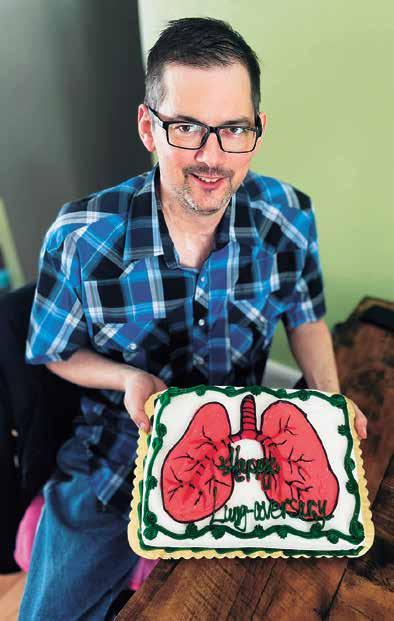
Since his return home, Adam has been working his way back into the operation of the farm, working with records and crop planning as well as running the skid loader.
“I really missed the farm, the cows, the crops,” Adam said. “There are older cows that are gone now, and new heifers that I don’t know; the milkhouse got rebuilt. There is just so much. I am especially looking forward to seeing the crops again this year.”
Adam said the gratitude they have for their family and friends who have helped them through the past year is immeasurable.
“I remember being in the


hospital thinking we’d just have to sell the cows, that there was no way Annie could keep everything going on her own,” he said.
Adam’s father helped the family carry on.
“When he should have been retired, he came back to the farm and helped run everything,” Adam said.
Adam’s brother-in-law also took care of feeding every day before going to work.
“Our moms and aunts have been a huge help with the kids,” Adam said. “Annie took on so much responsibility on the farm besides the kids. We can never thank everyone enough.”
For Annie, selling the cows did not seem to be an option.
“Adam promised me he’d be home, so I knew I had to keep it going,” Annie said.
Annie’s joy at her husband’s homecoming is overwhelming for her.
“You don’t realize what a huge part one person plays in your life until they aren’t right there with you every day,” Annie said.
Adam said one of the hardest parts of his recovery was being cooped up indoors.
“In a year, I only got to get outside three times,” he said. “You don’t realize how important that is to you until you can’t do it.”
Now that he is home, the
Hedlunds are tasked with juggling their farm and young family with Adams’ many appointments, physical therapy and dialysis. Because of the trauma suffered by his body, Adam’s kidneys suffered damage, and he will soon be placed on the list for a kidney transplant.
Adam must follow a strict regimen of medication. Besides anti-rejection medications, he is on eight to 10 other medications and supplements.


The Hedlunds said as they celebrate the one-year anniversary of Adam’s new lease on life, they realize the sacrice that was made by another family to grant their wish.
“You try not to think about the bad part and just think about the good part: that someone who could no longer use their lungs gifted them to me,” Adam said. “The appreciation and respect I feel for someone to do this for another person, ... it is immense.”
Thinking about that selfless donor, and what the gift has meant to his young family, is emotional for Adam.
“It was pretty hard, everything I have been through,” he said. “I dreamed of getting home, and sometimes I was afraid I wouldn’t make it home. Now, I am with my family, and sometimes I wake up and am afraid it is all just a dream; but it’s not, it’s real, and I am here.”









DENMARK, Wis. – For third-generation dairy farmer Zack Lacenski, his farm’s past is as important as its future. In the family for 72 years, Lacenski values the contributions every generation made to the farm and the help they continued to provide when ownership changed hands.
“Through the years, older and younger generations help the one who owns the farm,” Lacenski said. “My dad helps with chores and eldwork, and when he bought the farm from my grandpa, my grandpa helped him until he couldn’t walk anymore. My boys are getting old enough to start helping on the farm now too.”
Lacenski and his wife, Ashley, and sons – Jacob, Adam and Abraham – milk 40 cows and farm 300 acres near Denmark. Cow numbers on the Lacenski farm have remained constant for decades. Like the generations preceding him, Lacenski does not see a benet in growing bigger.
“We want to stay at this size,” Lacenski said. “My dad always said, people gured 40 cows for one family was sufcient, and that works for us.”

Lacenski graduated from technical college in 2005 and worked full time as a mechanic doing farm equipment repair until 2017 when he purchased the farm from his parents. He continues to work part time at the same repair shop as his schedule allows.

“Mechanical knowledge comes in handy on the farm,” Lacenski said. “I haven’t had to pay anyone to x tractors for a long time.”


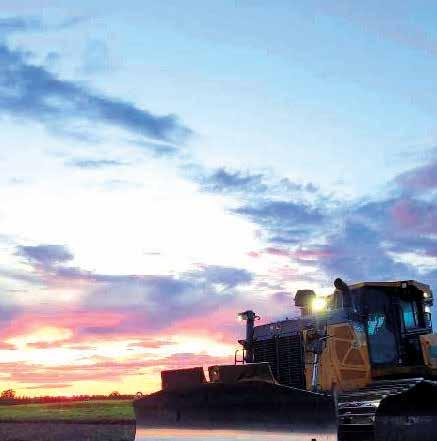
Lacenski’s grandfather farmed on the other side of the interstate before buying the current farm in 1951. Highway 43 separates the two farms, and Lacenski continues to farm the land that was part of the original homestead, which is owned by his 94-year-old grandmother.
The timeless red and white barns on his property are a nod to the past while fullling a current purpose. Like his father and grandfather, Lacenski makes improvements to the farm without altering its integrity.

The tiestall barn was remodeled and expanded in 1963 to hold 40 cows. A fresh coat of red paint in 2019 brightened the barn’s exterior, just in time
for a tractor show held on the farm that year. Lacenski is involved in several antique tractor clubs.
“I’ve been going to antique tractor shows since I could walk,” he said.
Since taking over, Lacenski modernized the barn’s milking system by taking out the steel vacuum line and putting in PVC along with new pulsa-



tors. The family milked with the same system from 1963 to 2017. They continue to use the same pipeline but also updated the recovery pump and pipeline wash control box. Ashley, who has worked on several area farms, does most of the milking.
“She has been on lots of farms over the years and has seen many ways of doing









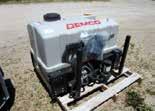

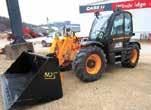
things,” Lacenski said. “She prefers milking in a tiestall barn over a parlor.”



Ashley has changed some of the farm’s milking procedures since she and her husband took over and now follows a pre-dipping and postdipping protocol.

“She does a good job with somatic cell count,” Lacenski said. “We keep everything clean and have won an award for quality milk.”

The Lacenskis ship their milk to Scray Cheese in De Pere.
“It’s a small cheese factory with only about 20 farms, and they have the best cheese curds around,” Lacenski said.
A maternity pen in the barn allows Lacenski to keep a few more cows. Previously used to house heifers, he had the box stall grooved to make it conducive for animals about to calve.
Lacenski also upgraded the barn lights last September from uorescent tubes to LED tubes.
“The LED lighting is way brighter,” he said.


Dry cows and heifers are housed in a barn built by Lacenski’s grandpa in 1941 on his rst farm.

“My dad moved that barn here in 1996,” Lacenski said. “I missed the rst day of sixth grade camp to see the barn come home.”

Not willing to let go of a functional building, Lacenski’s father remodeled the barn, converting from stanchions to free stalls. Rather than erect a new facility, the building was transformed into dry cow and heifer housing that met the family’s current needs. The barn holds 35 head and features a center feed alley along with a barn cleaner chain for labor-free cleaning. Small bales are stored in the hay mow above.
“We make a lot of small bales,” Lacenski said. “They’re easy to feed in the heifer facility, and they’re cheaper
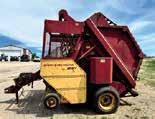

to make than round bales. We try to do things as efcient as possible – both in the barn and on the eld.”



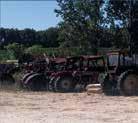
Cows do not receive a total mixed ration but instead are fed a diet of haylage, corn silage, protein mix, mineral mix and high-moisture ear corn.

“We put up as much high-quality feed as we can,” Lacenski said. “We still pick corn with a corn picker and run it through a roller mill on the silo. I’m going to consider cover crops in the future for extra feed and also because they are good for the ground.”

All animals are fed by hand, which Lacenski does not seem to mind.
“It’s good exercise,” he said.
Last year, Lacenski added a stacking slab for manure storage. Instead of hauling manure daily, the slab allows him to temporarily store manure and avoid spreading in cold, windy or snowy conditions.
“The stacking slab makes loading a lot more efcient,” he said. “It’s a nice improvement.”
Lacenski also raises 40 head of steers on a farm he rents from a neighbor. His next goal is to build a new shop and storage shed. The new building will free up one end of his current shed, allowing Lacenski to bring his steers home.
Efciency is woven into tradition and simplicity on the Lacenski farm as the fourth generation starts to help the third. Lacenksi is committed to preserving the past while updating the farm for the present, and he and his wife nd their small family farm to be the perfect place to raise a family.








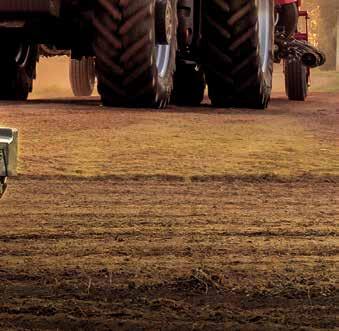



Tell us about your farm. My husband, Todd, and I have two children. Our son, Jared, is home on the farm after graduating from high school in 2021. Our daughter, Macie, is a freshman at Plymouth High School. Our kids are the fth generation on our farm, A-B-Lane Farm and JaMac Holsteins. The farm was a century farm in 2018. It consists of 375 acres both rented and owned, 65 registered Holsteins and Red and White Holsteins that are milked in a tiestall barn, and around 120 head of youngstock including steers.

What is a typical day like for you on the dairy? A typical day for me begins with getting our daughter off to school. When I get home, I head to the calf barn to feed and bed our calves. My husband, son and I then try to have breakfast together. When the guys head out to do more morning chores, I often times start laundry, get something going for supper, bake some treats for the family, etc. I am available most days if the guys need help with anything, like other chores, feed runs, weaning, vaccinating and moving cattle. I will also help in the elds if they need help. Each day is different.
What decision have you made in the last year that has beneted your farm? I don’t think we have made any major specic decisions in the last year other than the day-to-day decisions on the farm. In the last seven to eight years, we have installed tunnel ventilation in our milking barn and heifer/dry cow barn, built a calf barn and built a dry cow barn. We started making baleage instead of trying to make dry hay which sometimes can be a difcult task in eastern Wisconsin. We have been classifying cows again, which helps us make breeding decisions and has helped us improve the genetics in the herd.




 Kara Abraham Plymouth, Wisconsin Sheboygan County 65 cows
Kara Abraham Plymouth, Wisconsin Sheboygan County 65 cows
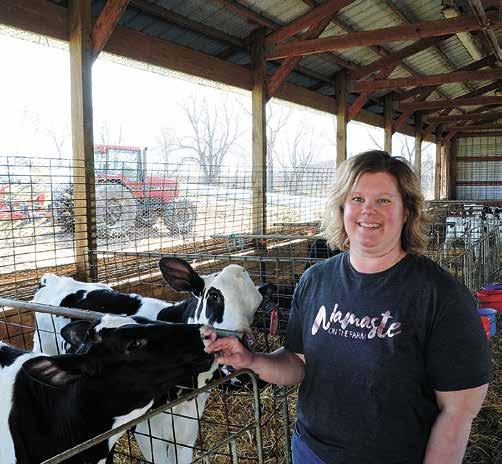

Tell us about your most memorable experience working on the farm. When one of my Red and White Holsteins was diagnosed with a twisted uterus at seven months in her pregnancy. Our veterinarian suggested we try rolling her to see if it would untwist, but it was unsuccessful. He then performed a cesarean section on the lawn. The calf did not make it, and the heifer was very sick. But with lots of TLC, she made it through. She has since successfully delivered more calves with no issues other than a displaced abomasum surgery. She is currently classied EX-90.


What have you enjoyed most about dairy farming or your tie to the dairy industry? I enjoy raising our kids on the farm. They learn early in their lives about life and death, but I feel it makes them better, stronger people as they grow up. I enjoy watching our kids raise their animals and the love and respect they have for them. I like that we are all working toward the same goal at the farm.
What is your biggest accomplishment in your dairy career? My biggest accomplishment in dairy is that we are still here dairy farming at our size. Our family is making this farm successful even with the stress and problems you have on a farm. We are all proud of what we do.

What are things you do to promote your farm or the dairy industry? The farm has sponsored a few things for the dairy youth, and we have had some school kids out to the farm when our kids were younger. The dairy judging teams come out for practice. I also post pictures of what we are doing on the farm on my Facebook page.
What advice would you give another woman in the dairy industry? Take time to get away from the farm – either by yourself, with your husband or with friends. Also, stand up for yourself. It can be hard, but your voice needs to be heard too.
When you get a spare moment, what do you do? I absolutely love to watch and support my kids in whatever they do. I also like to bake, and I enjoy photography. I don’t know if I should admit this, but I do enjoy a couple of “The Real Housewives” series. That is something I watch after everyone else has gone to bed at night.
Starting June 11, all currently available over-the-counter antibiotics will only be available as prescription medications.
Like the Voluntary Feed Directive rule change from several years ago, this new guidance from the U.S. Food and Drug Administration is part of a larger effort to mitigate antibiotic resistance. Whether justied in further regulating these valuable tools or not, they will be placed under veterinary oversight to keep them available to livestock producers.
All currently available over-thecounter antibiotics will only be available as prescription medications starting June 11. This includes but is not limited to the following: penicillin, oxytetracycline, sulfa antibiotics and mastitis tubes.

Some medications are not considered crucial for human medicine and will remain over-the-counter. This includes the following: ionophores, i.e., Rumensin, Bovatec; parasiticides, i.e., Ivermectin; oral pre/pro/postbiotics;
and topical non-antibiotic treatments.
This new rule will impact all livestock species. Goats, sheep, horses, pigs and cows will all be affected by the rule change. In some ways, smaller producers may be impacted more than larger producers, which are more likely to have already occurring routine veterinary visits.
Over-the-counter antibiotics are moving to prescription only to provide more veterinary oversight. Similar to the VFD, placing antibiotics under the supervision of veterinarians should result in more judicious use and less antibiotic resistance.
Livestock producers must have a valid Veterinary-Client-Patient Relationship in place before they can be prescribed antibiotics by a veterinarian.
A VCPR is a working relationship between a veterinarian (veterinary clinic) and a client. Ideally, a VCPR is a documented agreement between both parties that includes a dedicated visit to the animal location(s) the client operates. This visit and documentation must occur at least once every year.
The main question you should be
prepared to answer is how you are using antibiotics right now. This includes what antibiotics you use, how you administer each antibiotic, and when and why you administer antibiotics.
Hopefully this rule change sparks meaningful discussion with your veterinarian about how antibiotics are used in your system.
As an example, I often point to conversations about treating calf scours. Most calf scours cases are caused by non-bacterial pathogens – cryptosporidium is a parasite, and rotavirus and coronavirus are viruses. This means that most cases of scours do not require antibiotics, and if you are using antibiotics for every case, you have an opportunity to save money and use antibiot-
Dana Adams, adam1744@umn.edu
320-204-2968
Joe Armstrong armst225@umn.edu
612.624.3610
Luciano Caixeta lcaixeta@umn.edu
612-625-3130
Gerard Cramer gcramer@umn.edu
612-625-8184
Marcia Endres miendres@umn.edu

612-624-5391
Joleen Hadrich jhadrich@umn.edu
612-626-5620
ics more judiciously.
While a prescription is needed from your veterinarian to purchase the medications, you are not required to purchase them from your veterinarian. However, supporting your local veterinarian is like supporting any other small business that you wish to continue to be in business, and buying medications from your veterinarian is one way to support their business.
Ideally, identifying a veterinarian and a VCRP would happen before the deadline of June 11. Veterinarians will have many requests to renew VCPR’s at the time of the rule change, and getting it done ahead of time will save you the stress of trying to get an appointment at the same time as everyone else.
Les Hansen hanse009@umn.edu
612-624-2277
Brad Heins hein0106@umn.edu
320-589-1711
Nathan Hulinsky huli0013@umn.edu
320-203-6104
Karen Johnson ande9495@umn.edu
320-484-4334
Emily Krekelberg krek0033@umn.edu
507-280-2863
Claire LaCanne lacanne@umn.edu
507-332-6109
Brenda Miller nels4220@umn.edu
320-732-4435
Erin Royster royster@umn.edu
Isaac Salfer ijsalfer@umn.edu
320-296-1357
Jim Salfer salfe001@umn.edu
320-203-6093
Mike Schutz mschutz@umn.edu
612-624-1205
Melissa Wilson mlw@umn.edu
612-625-4276
Isaac Haagen hagge041@umn.edu
612-624-7455
› Self Unloading
› Self Loading (If Tires Are Stacked Properly)






› Haul Up to 80 Sidewalls (Varies Depending Loader) or 110 with wheel loader tire shooter
› Reach over 18’ Cement Walls (Varies Depending Loader)


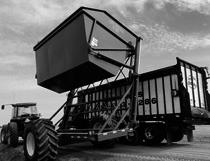


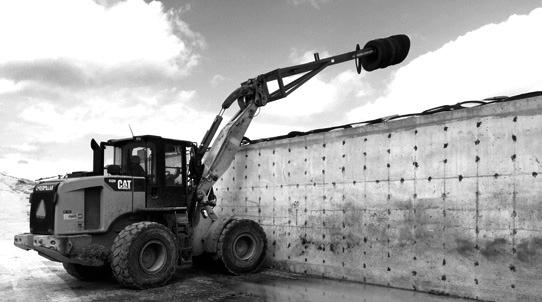
› Drop Sidewalls 22’ from Edge of Plastic on skid steer or telehandler,



OSSEO, Wis. – Casey Welke remembers bringing cows in from the pasture at 5 a.m. with her dad when she was a young girl. Now, she is making those memories with her children by raising them on a small dairy farm of her own.
“I remember he’d hold my hand in the dark and we’d go get cows in,” Welke said. “I feel like when kids grow up on a farm, they learn discipline and work ethic and a routine.”
Welke milks 30 cows in a tiestall barn with her husband, Cody, and their two young children, Evan and Hailey. The herd consists of Holsteins, a couple Brown Swiss and one Red and White Holstein. Welke manages the dairy while Cody works off the farm as a milk hauler.
“I start early,” Welke said. “That way if she (Hailey) wakes up, I have a little leeway to still get done on time.”
Typically, Cody will mix a batch of feed in the morning before leaving with the milk truck and then haul manure when he gets home at night. In between, Welke milks, feeds calves and does herd work. The couple works together to keep track of their children who are 3 years old and 3 months old.
Welke worked at her parents’ farm in Dorchester alongside her siblings un-


til her dad encouraged her to start buying her own cows. By the time Welke had 15 cows of her own, she felt like it was time to branch out from her parents’ farm. She and Cody had been dating about a year at that time, and there was an empty barn on the farm he was renting. They joined forces and started dairy farming at the rented site in 2016.
First, the barn had to be set up for dairy cattle. There was no pipeline, bulk tank or other milking equipment, and some of the milkhouse needed to be repaired as well. Cody’s dad played an integral part in readying the barn and farm.
“His dad has been a big help here,” Welke said.
Once the barn was ready, the cows were moved in and a few more cattle were purchased to get to about 25 milking cows. This left some room for the springing heifers that Welke also brought to the farm.

Since they rent the barn, the couple does not grow any of their own crops. Rather, the cows are fed a total mixed ration with purchased feed. Initially, they fed western hay in their ration, but the 190 relative feed value proved to be too intense for the cows. They have since transitioned to feeding dry hay and adding water to the mix to discourage sorting. They also add corn silage, protein, grain and minerals in the mix.
The cows are averaging 97 pounds of milk per day, based on the tank average.
“Our nutritionist, Holly Vasfaret, is probably the one that got us where we are now,” Welke said. “She’s really good at what she does.”
Vasfaret works with Famo Feeds

through Hegg Mill LLC of Ettrick.
The couple said it was challenging both times Welke took time away from the barn for maternity leave when their children were born. Cody tried to manage the breeding program but struggled because he also had to work off the farm. While they did have some help from other family members, they said things tend to go more smoothly when Welke is in the barn every day.
All the replacement heifers are raised on the farm. Calves are fed milk replacer and housed in hutches. Welke said she has better luck with homegrown replacements than purchased heifers.
“We were hoping to be up to 40 cows by now, but you can raise them
better than you can buy them,” she said.
In the last year, they added three barn fans with the help of Cody’s dad and implemented new milk machines. Welke has also been diligent about culling cows that do not produce a certain amount of milk, which has helped their milk average.
In the future, the Welkes said they hope to buy the farm. They would like to stay where they are and continue to chase the dream of raising their kids on the farm. Welke believes their goal is possible.

“We seem to be managing,” she said. “He still has to work off the farm, but he loves driving truck. And, we’re not milking a lot of cows either.”
USED TRACTORS

2022 Bobcat CT-1025, Loader, 60” Mid Mower, 36 Hours ..................$16,000
1985 Allis Chalmers 8030, 4665 Hours$24,500
1982 White 2-155, 5750 Hours, Nice Looking ......................................$19,500
USED SKIDSTEERS

2017 T-650, Glass Cab with A/C, 2 Speed, Hi Flow, 2500 Hrs ..............................$49,500
2017 S-770, Glass Cab with A/C, 2 Speed, 3900 Hours .........................$35,900
2021 S-76, 2500 Hours .......................$43,900
2018 S-650, Glass Cab with A/C, 2 Speed, 1025 Hours .........................$51,500
2014 Toro 22321, 1251 Hours, Tracks Good, Gas ...............................$15,900
USED TILLAGE
2012 W-R 13QX2 50’, 5 Bar Spike Harrow .......
$28,500
2012 W-R 13QX2 34’, 3 Bar Harrow
w/Rolling Baskets ..............................$29,500
W-R 2500, 28’, 4 Bar Harrow .................$6,950
(3) W-R 513 Soil Pro, 9 Shank ........Starting at $25,000
2011 W-R 5800 Chisel Plow, 39’ .........$25,500
2012 G-P TCN-5107, Disc Chisel, 7 shank ..............................................$10,900

J-D 2700 Plow, 4 Bottom, Vari Width ....$1,500

USED PLANTERS White 6700, 12x30, Verticle Fold ...........$7,500 Case I-H 900, 12x30, 3 Point .................$4,950 USED HAY EQUIPMENT
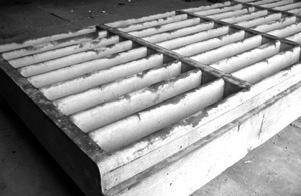
2014 N-H 316 Discbine, 15’ Cut ..........$28,900 1997 N-H 1465, 9’ Haybine ....................$9,500
New Idea 5212 .......................................$8,950
John Deere 260 Dsicmower ...................$3,500
N-H 790, 824 Cornhead, Hayhead..........$7,950
Meyer 500TSS Forage Box.....................$7,500
2020 N-H
Spring is nally here. The sun has some power now. Very soon, the tractors will be rolling. Please ensure safety is your number No. 1 priority. The Farm Service Agency wants to be sure you are aware and apply for any opportunities regarding programs and their deadlines. As new programs and information continually come up and change, we are doing our best to provide the most accurate and current information and still administer the existing programs.
Agriculture Secretary Tom Vilsack announced that producers in counties affected by eligible disaster events in Kentucky, Minnesota, South Dakota, Illinois, Indiana, Iowa, Missouri, North Dakota and Tennessee can apply for cost-share assistance through the Emergency Grain Storage Facility Assistance Program. The new program provides cost-share assistance for the construction of new grain storage capacity and drying and handling needs in order to support the orderly marketing of commodities. An initial allocation of $20 million in cost-share assistance is available to agricultural producers in affected counties impacted by the damage to or destruction of large commercial grain elevators as a result of natural disasters from Dec. 1, 2021, to Aug. 1, 2022. The application period opens later this month and closes Dec. 29.
This assistance is designed to help producers affected by the December
2021 tornadoes that passed through 11 counties in Kentucky, as well as producers in Illinois, Indiana, Iowa, Minnesota, Missouri, North Dakota, South Dakota and Tennessee affected by eligible disaster events in 2022.
Maps showing the location of damaged grain facilities in Kentucky, Minnesota, South Dakota and surrounding eligible areas are available online. These maps depict damaged storage facility lo-cations and the affected counties within a 30-mile radius of these facilities where producers may be eligible to apply for EGSFP benets if they can demonstrate a need for additional onfarm grain storage capacity.
Additionally, FSA may determine a need for EGSFP assistance in counties in other states and regions during the application period where an eligible disaster event has damaged storage facility locations. Eligible disaster events include hurricanes, tornadoes, oods, derechos, straight-line winds and winter storms that occurred between Dec. 1, 2021, and Aug. 1, 2022.
EGSFP helps producers build permanent or temporary on-farm grain storage capacity, re-store existing storage capacity, and purchase drying and handling equipment in affected counties.

The following types of new/used facilities and upgrades are eligible for cost-share assistance and must have a useful life of at least three years: conventional-type cribs or bins designed and engineered for grain storage; open
buildings with two end walls; converted storage structures; asphalt, concrete or gravel oors with grain piles and tarp covering; and ag baggers (including bags).
On-farm grain storage structures may account for aeration, drainage and may require loading or unloading augers, drying and handling equipment.
Producers must submit the EGSFP Application, form FSA-413, and any additional required forms to their FSA ofce starting later this month and by the Dec. 29 deadline. Form FSA-4131, Continuation Sheet for EGSFP, must be submitted with the FSA-413 when a group of producers are applying for assistance.
FSA will use the producer’s selfcertied cost of the additional on-farm grain storage capacity or drying and handling equipment needed multiplied by the producer’s share of grain. This amount will then be multiplied by the cost share factor of 75% or 90%. An eligible producer who certies they are socially disadvantaged, limited resource, beginning and veteran farmer or rancher by ling form CCC-860 with FSA will receive the higher 90% cost share rate.
Timely report ownership, operator changes
Producers who are buying or selling agricultural land need to notify FSA as soon as possible following transaction for timely update of FSA farm records. To report an ownership change, provide either a copy of the recorded warranty
deed or a contract for deed to FSA.
If you will be renting new land, the FSA needs a copy of the lease before we can add you to the farm and/or give any information about the farms such as maps, base acres, yields and program elections. If an operator is dropping rented land, we appreciate notication of those changes also for updating of records.
Producers who have transferred their land into a trust also need to timely report this change to the FSA ofce. To record an ownership change to a trust, the trust, grantors or trustee(s) need to provide a copy of the recorded deed.
Ownership changes involving land enrolled in the Conservation Reserve Program need to be reported to the FSA once the deed is recorded at the county recorder’s ofce. Failure to timely report an ownership change (including land being transferred from an individual to a trust, etc.) for land enrolled in CRP could result in termination of the contract and require a refund of all payments received under the applicable contract. FSA is not notied by the county recorder’s ofce of these sales. In addition, notify FSA if your bank account has changed.
Farm Service Agency is an Equal Opportunity Lender. Complaints about discrimination should be sent to: Secretary of Agriculture, Washington, D.C., 20250. Visit www.fsa.usda.gov for necessary application forms and updates on USDA programs
How did you get into farming? I was going to school in Chicago and ended up moving to a farmette in Wisconsin. I discovered agriculture classes in the new high school, and from that point on, I took all of the ag classes I could. I worked on neighboring farms and loved it. I went off to college and got married and always had a dream of farming. It didn’t happen for me until I was in my 40s. My wife and I went on day trips looking for a farm and found this one in Viroqua. We had six kids that we home-schooled at the time. It was one miracle after another to make this work. It was hard. We moved here in December 2002.
What are your thoughts and concerns about the dairy industry for the next year?


I am concerned about the pay prices that do not cover the cost of production. Until the dairy industry chooses or is forced to organize, this will not stop. The lawmakers need to realize that we cannot x this on our own.
What is a recent change you made on your farm and the reason for it? I bought a skid loader last year. I am still learning how to use it, but it makes chores easier and allows me to do a better job.




Tell us about a skill you possess that makes dairy farming easier for you. Before farming, I worked for many years in diagnostics and repair in the manufacturing industry. From that, I have a good understanding of
machines and electronics of all types.
What is the best decision you have made on your farm? It sounds simple, but the choice to milk cows was the best decision I ever made. Of all the things in my lifetime, milking cows and rotational grazing have been the most fullling.
What are three things on the farm you cannot live without? My wife, who I have been married to for 42 years, because we are good for each other. My neighbors,
who have been a tremendous blessing, and electricity, which allows us to keep milk cooled, run the silo and many other things. I am thankful to have access to it.





What strategies do you use to withstand the volatile milk prices? I work with my neighbors and vendors to communicate and make payments. It has been a community effort.
How do you retain a good working relationship with your employee? I have one part-time employee, and we
are considerate and patient with each other. I am here to work with them, not to just have them work for me.
What do you enjoy most about dairy farming? Working with cattle in good times and in bad. It has put me more in touch with humanity than anything else in my life.
What advice would you give other dairy farmers? Avoid debt, and the banker is not your friend.
What are your plans for your dairy in the next year and ve years? In the next year, I plan to improve the facilities and the fences and just generally x things. In the next ve years, I plan to still be here. I want to make sure there is a farm here for someone else someday. I know others have lived here before me, and there will be others after me. I consider myself a link in that chain.
How do you or your family like to spend time when you are not doing chores? I like to plan dinner or activities with my grandkids.




• Rear-mounted disc mower equipped with hydraulic lifting
•ENOCUT cutter bar, specially designed by Enorossi for a quick and clean cut
• Automatic Protection System helps prevent damage to the bar from obstacles
• Automatic hydraulic leveling system helps protect the turf
• Go from working to transport position without leaving the tractor seat

I was 17 when I ofcially met my husband, Jason. He was two years ahead of me in high school, and while I admired him from afar while we were in school, he had already graduated by the time we made our acquaintance at a country music festival.
My parents allowed me to attend the festival with my friend, her older brother and his group of friends. Jason was included in that group, and when I saw him around the campre that night, I couldn’t believe my luck.
He had one big thing going for him: He was a farmer.

McHale Round Baler with Variable Chamber and 15 Knife Chopper

•Known
•Double
•Excellent value for the money


•Save time and earn more on higher quality hay

•RA rake’s larger outer wheel contacts the ground and turns a smaller inner wheel to rake hay without contacting the dirt



•Decreases ash while Increasing speed—the world’s only double wheel V-Rake windrows the crop and leaves the ash behind
 By Abby Wiedmeyer Staff Writer
By Abby Wiedmeyer Staff Writer

My idea of farming back then was mostly based on romantic country songs and memories of playing at my cousins’ beef farm as a kid. When Jason and I started chatting that night, he told me he worked on a 450-cow dairy farm and spent his days driving tractors and taking care of animals. The stars practically popped from my eyes as I swooned over the thought of how cool that sounded. It didn’t take long for him to catch on, and he invited me to go for a tractor ride once the festival was over and he was back to work.
I had no idea this would set the bar for what would be considered a date for the rest of my life. The rst tractor ride I went on, Jason hauled a load of liquid manure from the parlor drain while I rode along. Can you think of anything more romantic? I was enamored with how easily he could operate the equipment and how far we had to travel just to empty the spreader in about two minutes. He was impressed the smell did not bother me one bit.
I asked about a million questions while he expertly shifted gears. I’m sure it wasn’t easy for him to play it cool because I was balanced on the armrest of his seat while we bounced down the road back to the farm. Anyone familiar with this arrangement knows this is only comfortable for two teenagers on the brink of love.
For the rest of the summer, I occupied that armrest while we hauled manure and chopper boxes for hours. We had so much time to get to know one another, and I also learned more about dairy farming.
We got married two years and many tractor rides later. On our wedding day, we rode from the church to the reception in a tractor with a hay wagon holding our bridal party and groomsmen while Jason and I were in the cab.
By the time we started farming on our own ve years after we were married, we already had small children and tractor rides were hard to come by. Once our kids became older, though, I snuck rides whenever I could. After over a decade of farming together, it might seem like the novelty would wear off. But, when I get the chance to ride on the fender of a tractor, it gives me a thrill that takes me back to my teenage years.
Our lives have evolved over our nearly 17 years of marriage, and now, we both work off the farm in addition to milking cows. Nowadays, Jason spends more time driving a milk truck than tractor, and his time at home is limited.
Imagine my delight last Saturday when he called and asked if I would ride in the milk truck for the afternoon. I quickly agreed, and when he pulled in with the rig an hour later, I climbed in and felt the years melt away. I am impressed he can drive just about any piece of equipment or truck, and I feel like a teenager when I get to ride along. It is also fun because we delivered milk to the same plant that our milk goes to, and it’s interesting for me to see that side of things.
We saw the owner of the truck and Jason’s boss at the dairy plant, and he mentioned there might still be a CD in the player of the truck. Lo and behold, it was an ‘80s hair band CD. We rode home while singing along to Poison. When we got home, our 16-year-old daughter was putting the last milkers on, our 14-yearold son was nishing feeding the cows and our 10- and 11-year-old girls were just getting done feeding calves.
It may not sound like much of a wild Saturday to some, but to me, it had all the vibes of our dating days. Only, it was better because we got to see the fruits of our parenting in four honest, hard-working kids who all had participated in sports that day and then took care of chores.
I had no idea when I went on that rst tractor ride almost 20 years ago what it would lead to. It hasn’t all been sunshine and tractor rides, but if we still enjoy those when we can, we’re doing all right.

Wisconsin is experiencing a labor crisis. It is no different than any other state.
All businesses are looking for help. It is estimated that there is a shortage in our state of nearly 45,000 employees, and this shortage is impacting Wisconsin’s agriculture.
Dairy farms, fruit and vegetable farms, cheese plants and meat processing facilities are struggling to get employees who want to work and are committed to working the long hours re-quired.
Wisconsin agriculture generates one-third of our state’s gross domestic product, or $104.8 billion. The dairy industry is $45.6 billion of that GDP, according to the Wisconsin Department of Agriculture, Trade and Consumer Protection.
That is why we are America’s Dairyland.
Crops from fruit and vegetables are sometimes left to rot in the elds due to worker shortages. Cows must be milked, fed and taken care of all throughout the day every day. Farms without enough employees have to close.
We all are part of the last of Wisconsin’s dairy farms. There are about 6,000 dairy farms left. Many of us rely on immigrant labor. Last year, Wisconsin lost over 400 dairy farms. Many closures had to do with high input costs, but lack of help was another reason for dairy farmers to call it quits. Without immigrants’ help, we would not have the honor to be America’s Dairyland.
Immigrant labor is everywhere. In the dairy industry alone, many undocumented men and women have left their homeland to work in Wisconsin to improve their lives for their families. Many have traveled thousands of miles, some on foot, through deserts and other harsh environments risking their lives and their children’s lives to escape from unimaginable conditions. Even with all of the dangers they had to endure, it is safer here than where they were.
In Wisconsin, these men and women are not allowed to get a driver’s license. It was not always that way. The law was changed in 2006 with the Real ID law, allowing only people who enter the country legally to obtain a driver’s license.
I’ve been a part of a group of people called Voces de la Frontera. We have been advocating for the restoration of driver’s licenses for undocumented immigrants. Nineteen of our neighboring states, including Minnesota, have restored driver’s licenses for all who pass a written and driving test. This license would clearly read “Not eligible for voting.” This reduces the risk of voting fraud.
This process of legalizing driver’s licenses would generate revenue for the state with the associated fees and lower the cost of insurance. With a valid driver’s license, I believe these people would be less likely to leave the scene of an accident and would be more likely to come forward to work with law enforcement, report accidents and report crimes. These people could also be identied by rst responders in serious crashes.
Also, I think legalizing driver’s licenses would allow our roads and communities to be safer and more secure knowing who is living and working in our neighborhoods. It would put a name to a face and bring these valued employees out of hiding
from fear of law enforcement.


According to the policy organization Kids Forward, as estimated 32,000 Wisconsin residents lack driver’s licenses because of their immigration status, of whom 12,000 are parents of children who are U.S. citizens. U.S. Immigration and Customs Enforcement has targeted people stopped for driving without a license for detention and deportation, separating hundreds of Wisconsin immigrant families.
What does a driver’s license do for undocumented immigrants and their families? It allows them a safe way to get to work, to be able drop their children off at school and even go to the grocery store without worrying about a trafc ticket or accident. Children should not have nightmares about
law enforcement ofcers, parents not coming home from work or being detained for getting a trafc ticket or being in an accident. The fear is real. This is not healthy for anyone and is creating unnecessary stress and mental strain for everyone.
We must do better. We need driver’s licenses for all residents of Wisconsin. This will make our roads safer, our communities secure and our neighborhoods more welcoming to all people who work on our farms.
Tina Hinchley, her husband Duane and daughter Anna milk 240 registered Holsteins with robots. They also farm 2,300 acres of crops near Cambridge, Wisconsin. The Hinchleys have been hosting farm tours for over 25 years.


Editorial disclaimer: The views expressed by our columnists are the opinions and thoughts of the author and do not reect the opinions and views of Dairy Star staff and ownership.

•
•
•





cost per hour of running a tractor and mixer.
Mike Hanson from Goodridge, MN, started Vector feeding in September of 2016 (130 cows, dry cows, & heifers):
“Originally, the Vector system was not part of our plans for our new robotic facility. But after studying the system and viewing a couple in operation, we can’t see feeding any other way!”
Rick & Sarah Ahlgren from Darwin, MN, started Vector feeding in June of 2020 (180 cows & dry cows):

“The Lely Vector Feeding System has become a great asset to our farm. We really like how it mixes and delivers fresh feed to our cows—in small batches, many times a day. It saves time and fuel for our dairy every day. We are so impressed with the system!”
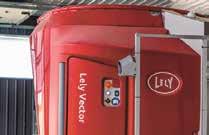
Tim & Derek Rolf (Golden Sunrise Dairy Inc.) from McIntosh, MN, started Vector feeding in late 2019 (180 cows & 180 dry cows & heifers):

“With heifers starting at 6 months all the way to milk cows, under one roof, the Vector allows us to feed an unlimited number of rations (we feed 6) with an unlimited number of ingredients. It also continually gives the cows a consistent mix and we all know cows love consistency!”
Vector systems help dairy & beef herds . Leedstone has already installed 3 Vector systems for beef steers! Call



For those longtime readers of my rambling columns, you will perhaps recall all of the joy surrounding the book Craig and Fred ve years ago. We coordinated a hugely successful Community Read based around this incredible book. The book has the power to bring readers of all ages together to discuss the story found within its pages. Author Craig Grossi, his infamous canine friend Fred, his then girlfriend (now wife) Nora Parkington, and her dog Ruby visited and gave presentations at the Hillsboro High School, Cashton High School, and the Tomah VA. Craig’s tale of the ‘stubborn positivity’ he learned from Fred resonated with everyone – and continues to spread.
Since that meeting all those years ago, Craig and I have kept in touch. The Young Adult version of Craig’s book has become a staple in the sixth grade curriculum and Craig does his best to coordinate a meeting in real life or virtually with the students. This past fall, he and Nora and the dogs joined us at the farm for a few days. We packed the days full of farm fun: from riding a four-wheeler through the mud in 40 degree weather to canning apple pie lling, feeding calves to milking cows. Through it all, they were
treated like members of the family. When they left the farm they left me with an open invitation to come and visit them in Maine.
I have never actually taken a vacation (because giving birth or having surgery to get out of chores does not count). I haven’t necessarily had the desire to before now, I suppose. I also was quite sure I didn’t need to board an airplane. Then one day I looked in the mirror and realized I wasn’t getting any younger and there were places and people I needed to see in this life. When my dear friend Molly announced her due date with baby number four, I promised her I would come and help out afterwards. I knew that this would force me to get on an airplane and head to Bliss, New York. Our mutual friend Laura was all in for the adventure, even with my many jovial warnings about the likelihood of me being an uneasy ying companion. It made perfect sense to attempt to t in a trip to Maine as well since we were already planning on heading east.
Plane tickets were purchased. That made all the thinking about it become very real, very fast. I was going to get on multiple planes and be gone for six whole days. I was
 Ramblings from the Ridge
Ramblings from the Ridge
going to leave my family, my cows, my comfort zone. I cooked up multiple pans of food. Two double batches of cookies went to the freezer (in case of emergency, you know), cake went to the fridge, and I even pre-cooked meals for Lucy so she would have plenty to sustain her after nursing those voracious puppies of hers. Then began the list making: cows to move, cows to dry, after school chores to do, food ready to eat. Cora loved her list. She felt like such a big kid having to check off her daily jobs.
Not surprisingly, her favorite job was snuggling the puppies.
Laura and I had uneventful ights to Buffalo, New York. I learned that the motion sickness that bothers me in a vehicle on the ground is not quite as prevalent in the air. Most importantly, I can read on an airplane. On Easter Sunday afternoon in sunny New York an ecstatic Molly and a slumbering six-week old Abigail picked us up. We spent the next few days burping and bouncing a baby, curling up with her other three young ones and reading wonderful picture books, playing ‘popcorn’ on the trampoline, and exploring nearby Letchworth State Park. Before this trip, I had only seen waterfalls of the magnitude of those at Letchworth in the pages of National Geographic – these were breathtaking and beautiful. I took over Molly’s kitchen and make a few meals for all of us, and now can put faces to names when she talks about the important people in their lives. It was relaxing and wonderful to spend time with Molly and her entire family on their turf.
By Jacqui Davison Columnist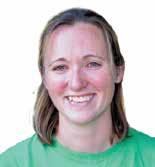




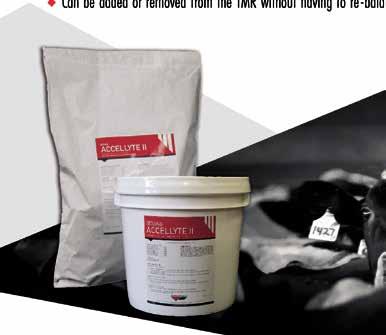
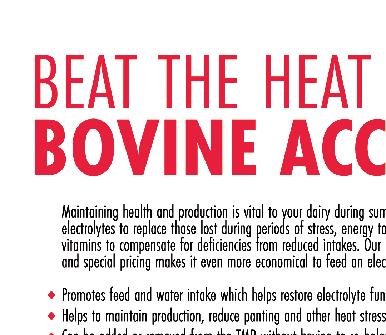
From New York we ew into Boston, the only ight that made my stomach a bit queasy due to the windy weather adding some serious turbulence. Nora grabbed us up and maneuvered her way through the tunnels and cramped streets of Boston to nd a parking spot so we could wander the historical streets before our journey up to Maine. Aside from being a bit breezy, the weather was spring-like and the streets were packed with locals and visitors alike soaking up the sun. It was a good thing Laura and Nora had experience in such a setting, because I could have oated around for hours admiring the old architecture and reading every historical plaque. All of it was incredible to this farm girl who had only visited such places in the pages of a book.
We made it up to Craig and Nora’s house in Maine that evening and gobbled up some delicious pizza. They were hesitant to feed us their cheese, in case it disappointed our spoiled dairy palates. It hit the spot. Fred and Ruby accepted us as house guests by the next morning, no longer so watchful of our every move. We visited an oyster farmer, then, in true farm to table fashion, devoured his oysters the next day as we sat on the beach by the ocean. Oysters grilled to perfection and doused with butter, garlic, and parsley. With the dogs in tow, we wandered the streets of oceanside towns and once again I marveled at all the history. Every path we took from their house seemed to take us past early cemeteries, with rock fences marking them off between the tall trees. So many of the houses looked as though they would love to tell the stories of past inhabitants.
We were gone from Wisconsin for six days, two hours and 59 minutes according to the airport parking meter. It was a trip of rsts for me in so many ways. From the food I tried, the sights I experienced, to the ve separate plane rides to get there and back. The animals and children all survived and I think were glad to see me come home, throw on my apron/overalls, and get back to my routine of reality. To think, most of this trip wouldn’t have been possible without the connection a book made years ago.
Jacqui and her family milk 800 cows and farm 1,200 acres of crops in the northeastern corner of Vernon County, Wisconsin. Her children, Ira, Dane, Henry and Cora, help her on the farm while her husband, Keith, works on a grain farm. If she’s not in the barn, she’s probably in the kitchen, trailing after little ones or sharing her passion of reading with someone. Her life is best described as organized chaos, and if it wasn’t, she’d be bored.

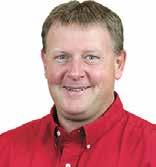
The Dairy Calf and Heifer Association held its annual conference April 11-13 in Prior Lake, Minnesota, bringing together youngstock producers and industry experts from around the country. One of the panel discussions, which featured three producers from across the Midwest, focused on group housing. Following are a few insights shared during that session.
bodyweight at weaning. These results are corroborated by research and were reiterated by the producer panelists at the DCHA meeting.



Researchers at the University of WisconsinMadison said many of the health concerns we see in calves reect problems in colostrum management, hygiene and sanitation practices, nutrition, housing strategies (ventilation), or preventive care and monitoring.



 By Barry Visser Nutritionist
By Barry Visser Nutritionist
Although many farms manage large groups of calves with good health outcomes, research has shown larger group sizes are a risk factor for health issues. UW-Madison researchers suggest pairs or groups of up to six to eight calves might have lower incidence of respiratory disease or diarrhea than groups of 15 calves or more. Most of the panelists had smaller groups of calves with some of this dictated by their feeding arrangements, such as a nine-calf headlock feeding system.
To minimize health risks and feed competition, the age gap within a group should be minimized. This can be a challenge in smaller herds with fewer calves born each week. Experts recommend the youngest and oldest calf in a group differ by no more than 14 days of age but ideally by seven days or fewer. Achieving this tight age range was typically not an issue for the DCHA panel farms. In some cases, entire barns are lled in less than two weeks. The use of multiple barns sized according to your operation can work well for lling entire barns in short periods of time. This all-in-all-out strategy allows calves to stay in the same group until the last calf in the group is weaned, with the option of keeping calves in their original pens for a while after weaning. The group is then moved all at once, and the entire pen can sit empty between groups.
ioned surface and promote calf hygiene. Moist environments harbor pathogens. Proper drainage can be part of the solution. Periodically removing bedding can also help keep pens clean and dry while also minimizing ammonia and improving air quality in the barns.
The DCHA panelists said they replace bedding in their group housing on a regular basis. In one case, the dairy never bedded on top of old bedding. Its pen conguration allows for easy movement of calves to the front or back half of the pens, which makes weekly cleaning and bed-ding efcient.
Recent literature reviews conducted by researchers from the University of Kentucky and the University of British Columbia have concluded housing calves in pair or small group housing can improve animal welfare, calf growth and consumer perception.
Calves are social animals and appear to thrive with companionship. They “play” more and are more active when group housed with more space. Calves raised with companions also show greater adaptability to change, including weaning and future larger group moves. Pair- or group-housed calves will try new feeds and consume starter grain sooner. The end results often include increased feed intake, greater average daily gain and a heavier
The age at which calves enter pair or group housing typically ranges from the day of birth to about 3 weeks of age. This range was represented among the producers on the panel with a variety of facility and management considerations. Farms that choose to group calves on the day of birth report lower infrastructure costs for individual pens. Other farms choose to house calves individually for the rst few days of life. Some farms wait until calves are drinking milk vigorously before moving them to a group. Other farms prefer to wait until after the peak of scours on their farm, which generally occurs within the rst 3 weeks of life. Work with your calf advisory team on the best age to pair calves on your farm.
An all-in-all-out system is certainly a biosecurity best management practice when achievable. This strategy makes for easy implementation of optimal sanitation protocols as well reducing the buildup of bacteria, viruses and other pathogens in the calves’ environment. Facilities on many farms tend to require a continuous ow. Good hygiene practices can still be achieved in these systems.
Bedding management is critical to preweaned calves as they spend most of their time lying down. Enough wellbedded space for each calf is essential. Expert recommendations for bedded resting space vary from 30 to 40 square feet per calf. Clean, dry bedding is important to create a comfortable, cush-
The DCHA panelists identied cross-sucking as a common concern. Excessive cross-sucking is thought to lead to frostbitten ears, navel infections, mastitis or udder damage. Strategies implemented by the panelists include slower nipples, keeping calves in headlocks for a few extra minutes postfeeding and adjusting feeding amounts.
Social housing for calves can improve dry feed intake preweaning and help improve overall weight gain during the transition from milk to dry feeds. Pair housing can be a simple solution for smaller farms. This can be accomplished by removing the partitions between individual pens or putting a common wire panel around two adjacent calf hutches. Pair or group housing of dairy calves can provide positive outcomes when attention is given to group size, cleanliness, proper nutrition and management.
Barry Visser is a nutritionist for Vita Plus.
9800 2020, Kernel Processor, PRWD, 1287 hrs., 833 CH hrs.,, #536344 ........ $497,000
JD 8700 2018, Kernel Processor, PRWD, 2327 hrs., 1849 CH hrs., #552442 ....... $284,000
JD 8700 2016, Kernel Processor, PRWD, 1840 hrs., 1103 CH hrs., #525709 ....... $324,000
JD 8700 2018, Kernel Processor, PRWD, 1701 hrs., 1069 CH hrs., #541389 ....... $348,500
Claas 970 2018, Kernel Processor, PRWD, 2257 hrs., 1639 CH hrs., #533174 .... $299,000
JD 9700 2020, Kernel Processor, PRWD, 1165 hrs., 653 CH hrs., #543646 ......... $503,000
JD 8600 2018, Kernel Processor, PRWD, 1651 hrs., 778 CH hrs., #188792 ......... $342,000
JD 8800 2016, Kernel Processor, PRWD, 2603 hrs., 1679 CH hrs., #175182 ....... $268,100

JD 7550 2009, Kernel Processor, PRWD, 2373 hrs., 1769 CH hrs., #560107 ....... $158,000
JD 8500 2016, Kernel Processor, PRWD, 2232 hrs., 1180 CH hrs., #555984 ....... $259,000
JD 8300 2022, Kernel Processor, PRWD, 33 hrs., #537501 ................................ $459,000






JD 9900 2019, Kernel Processor, PRWD, 1222 hrs., 884 CH hrs., #550177 ......... $493,000
JD 9900 2020, Kernel Processor, PRWD, 844 hrs., 661 CH hrs., #553436 ........... $508,000
JD 9800 2019, Kernel Processor, PRWD, 899 hrs., 661 CH hrs., #550175 ........... $503,000
JD 8500 2017, Kernel Processor, PRWD, 1460 hrs., 1070 CH hrs., #553938 ....... $299,000
JD 9600 2019, Kernel Processor, PRWD, 1720 hrs., 1130 CH hrs., #553763 ....... $349,900
JD 7500 2005, Kernel Processor, 4568 hrs., 3267 CH hrs., #547004 .................... $74,500
Claas 940 2020, Kernel Processor, PRWD, 650 hrs., 480 CH hrs., #532728 ........ $399,900

JD 9600 2019, Kernel Processor, PRWD, 1224 hr., 811 CH hrs., #532049........... $409,900
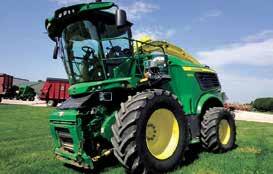

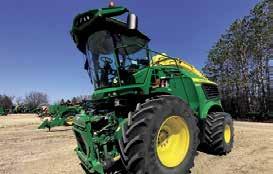

JD 7780 2013, Kernel Processor, PRWD, 3370 hrs., 2109 CH hrs., #274502 ....... $169,900
JD 9800 2020, Kernel Processor, PRWD, 1415 hrs., 942 CH hrs., #554135 ......... $459,900
JD 8600 2016, Kernel Processor, PRWD, 1650 hrs., 1200 CH hrs., #555841

JD
JD
JD
JD
In the blink of an eye, your life can change. Years can disappear in time, either forward or backward. An ordinary site across the horizon, an earthly spring smell or the sound of rain on a tin roof can take our minds to another place and time in the blink of an eye.

It seems like I’ve been blinking quite a bit lately.


The grandkids came over on Easter Monday. Decked out in puddle boots and light jackets, they ran around the yard trying to catch a gentle spring breeze with their new kites as they splashed through puddles. If their little legs could generate enough speed, the kites would gradually lift off the ground only to come crashing back down to earth when they stopped moving. After several crashes and some extra help from their uncles, the kites eventually stayed air bound.
The open space isn’t the only attraction for the kiddos to come to the farm. There are always tractor and four-wheeler trips to take around the elds. The

girls and I couldn’t go very far or fast on the fourwheeler. We were dodging puddle ponds, “raging ood” creeks across the eld and slushy snow as we scooted around the farm yard. Ethan was busy with Uncle Austin checking out the lay of the land in the tractor. I think he honked the horn the whole time from the yard to the far corner of the farm and back again. Thank goodness for sound guard cabs.
Once Ethan was back, the girls climbed up in the tractor, and Ethan hopped on the four-wheeler with Grandpa. The neighbors were stuck in the eld across the road. They needed to go check it out. The rapid thaw had also washed away the shoulder of a new road on the south side of the farm. So many things to investigate.
Mark blinked.
It seemed like just yesterday when he and our kids were off exploring new adventures around the farm. Now it was time to teach the next generation
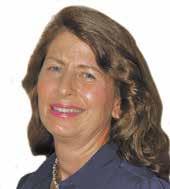


about the lay of the land.
Learn
The snowdrifts on the north side of the house provided a special playground for young and old alike that day. The drift was taller than my sweet little petunias, Emma and Ava. The snow was perfect. We grabbed handfuls of snow and started having a snowball ght with their daddy.
I blinked.
It seemed like yesterday Jonathon was the little one having a snowball ght across the yard with me. Now, here he is as the parent. Time seems to have melted as quickly as the snow.

By Wednesday, when it hit 80 degrees around here, the drifts disappeared like the Wicked Witch of the West. They melted slowly down into the ground, trying to escape the warmth of the sun’s rays. The grass was enjoying the slow melt as moisture sunk down to sleepy roots. Overnight, my tulips pushed upward to the warm sun. The grass was starting to green up. The apple trees started to send out buds. Spring was on its way. I blinked.
Sunday morning greeted me with new snowdrifts on the north side of the house. They aren’t quite as big and probably not as stubborn to hang around as the earlier drifts. I gure it is just a slow-release rain for the yard.
We have been quantum leaping around by seasons so far this year. In one week, we have gone from winter to summer, back to winter and now a normal chilly spring day. This time travel stuff sure keeps me on my toes.
I do know we can expect to be in the elds eventually. Mark is chomping at the bit. He likes to start planting by the end of April. I don’t think we’re going to make that date, but you never know. The Sunday snow is almost gone as the dark soil pulls the heat of the sun to the ground. Austin has buddies in southern Minnesota who already have been planting corn. In time, the planting wave will reach us, and we can hit the elds for another season.
As Mark counts down the days to start planting, I don’t get too excited about gardening. The last snow pile to disappear is standing in the middle of my garden. After each snowstorm, my garden was the dumping ground for the pushed snow in the yard. That includes all the extra straw from the front of the barn. The straw acts like an insulator for the frozen snow deep in the belly of the pile. I’ll nd other projects to work on until I can start crawling around and playing in the dirt with the grandkids.
I might have to pull out my tiller and work the edge of the garden to slip in some cool weather veggies like lettuce and spinach. Of course, I have to get some early red potatoes and peas in the ground for the perfect summer meal of creamed peas and potatoes. I guess I will be in the garden before long.
I have noticed the leaves of the rhubarb are right at the edge of the dirt, waiting for enough warmth to pop open their leaves like an umbrella. The irises and tulips have been pushing through the mulch on the south side of the house in search of more sunshine. After a couple of warm spring rains, the asparagus will sprout overnight. Once things wake up in the spring, it is hard to slow down.
It all seems to change in the blink of an eye.
As their four children pursue dairy careers off the family farm, Natalie and Mark are starting a new adventure of milking registered Holsteins just because they like good cows on their farm north of Rice, Minnesota.
how Bio-Vet’s DFMs & electrolytes can optimize your calf’s health.
Give them the support they deserve from DAY ONE! Our unique formulas provide beneficial bacteria to populate the digestive tract, high level nutrients, energy, and immune support.Natalie Schmitt Columnist
When my beloved cat, George, died unexpectedly, I put his body in the freezer until I could give him a proper burial. We were renting a house at the time and I didn’t feel it would be right to lay him to rest on land that didn’t belong to us. We buried him on my home farm the next time we went up north.



When a group of late-gestation heifers mysteriously started aborting, I kept a pair of bovine fetuses in the basement fridge until they could be sent off to the veterinary diagnostic lab.



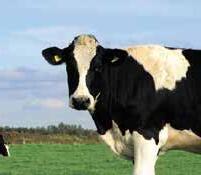
On the surface it feels odd, but I guess it’s not terribly unusual to have dead animals in the fridge or freezer. I know hunters keep heads and capes and hides frozen until they can be mounted or tanned. And, technically, all of the packages of beef, pork, and chicken in the freezer are parts of dead animals, but, I digress.
Much to our chagrin, Grandma didn’t make herself a glass of ice water right away like we expected. So none of us were in the kitchen when she rst opened the freezer. We didn’t see the moment, but we denitely heard about it. And we laughed.
I gured the mouse would move out after the joke, but he’s still sitting there – and I think he’ll stay. I’ve decided that keeping a mouse in the freezer is good for my heart.
Sadie Frericks Columnist


Every once in a while, I forget that the mouse is there, open the freezer, my heart startles, and I jump involuntarily. I gure it’s good to give your heart a shot of adrenaline every once in a while.





So, when Monika found a perfectly preserved frozen mouse in the snow this winter, we put him in the freezer. Here’s why:
First, because I have never seen a dead mouse look so alive. For that matter, I’ve never seen any dead creature look so alive. Perfectly preserved is an understatement. This mouse literally looks like he was ash frozen. He’s sitting upright, head alert. His tail is curled around to one side of his rump and suspended in mid-air like he’s twitching it. The scientist in me would love to know his actual cause of death.
Second, the kids wanted to keep the mouse for a practical joke on their grandma. Mice terrify my mother, which, unfortunately for her, has resulted in decades of jokes involving real and fake mice. Being that I love a good laugh, I allowed the frozen mouse a spot in the freezer.
Third, I wanted to applaud Monika’s discovery of the mouse. Observation – paying attention to everything around us – is a practice I try to cultivate in our kids. Observation is essential to our success as dairy farmers (“See how that cow looks a little off?”). Observation also adds great joy to our lives (“See the agate? See the caterpillar?”).
When my mom called to say she was coming to visit, the anticipation in our house reached palpable levels. The mouse was positioned in the freezer on the middle shelf just in front of the ice bin. When you opened the freezer, it legitimately looked like a real, live mouse was sitting there looking back at you.
I recently went mountain scrambling for the rst time. Scrambling being more than hiking, but less than full-on mountain climbing. Much of the path to the summit involved scrambling over rocks on all fours. There were a few narrow ledges and vertical passes that did more than startle my heart – they sent it into near panic. I realized that my current life is pretty calm in comparison. It’s not that I avoid adrenaline-rush activities; I just don’t seek them out like I did in my youth. Cliff jumping and motorcycling do as much to remind me of my mortality as they do to make me feel alive. Perhaps recognizing that tradeoff is what comes with maturity. But that doesn’t mean life should be adrenaline-free. Jumping at the sight of the mouse in the freezer is a microdose of feeling alive.
And then, after I jump, I laugh, because I know the mouse is there and it’s silly to be startled by a tiny rodent. Laughter is equally good for the heart. As a family, we laugh together a lot. I’m incredibly grateful that I married a man with a great sense of humor and that our kids inherited his humor. Their humor and penchants for practical jokes keep me laughing.
Finally, the mouse in the freezer is a good reminder to be observant. Pay attention. Look up and look around. Notice the little things. Our world is full of wonders. Observation leads to appreciation and gratitude. Gratitude is good for our hearts.
If the mouse in the freezer had a motto to share, it’d be this: Do things that make you feel alive. Laugh often. Be observant.


Sadie and her husband, Glen, milk 100 cows near Melrose, Minnesota. They have three children – Dan, Monika, and Daphne. Sadie also writes a blog at www.dairygoodlife.com. She can be reached at sadiefrericks@gmail. com












